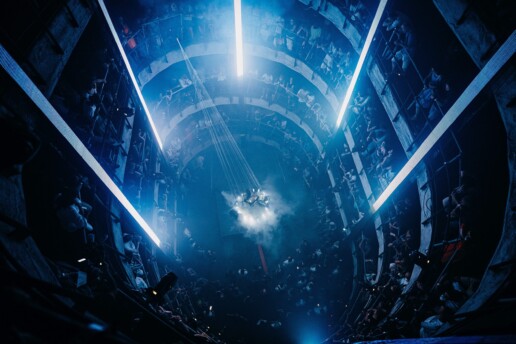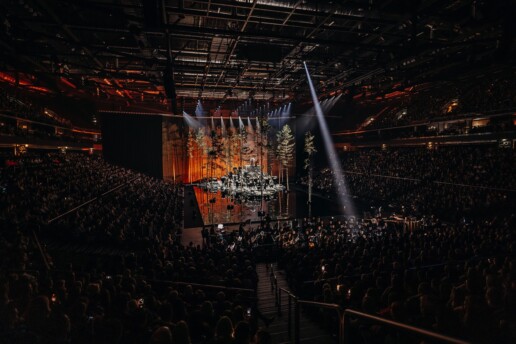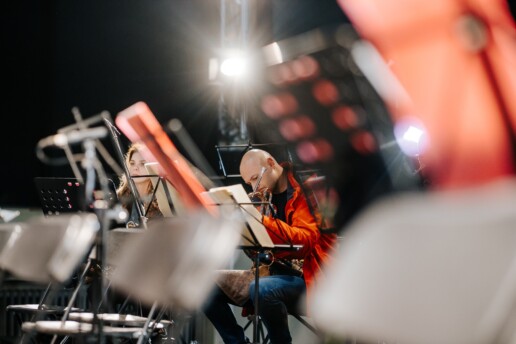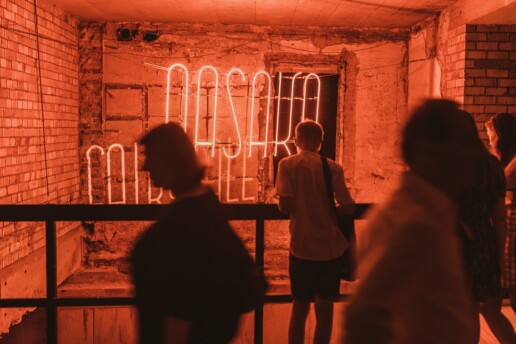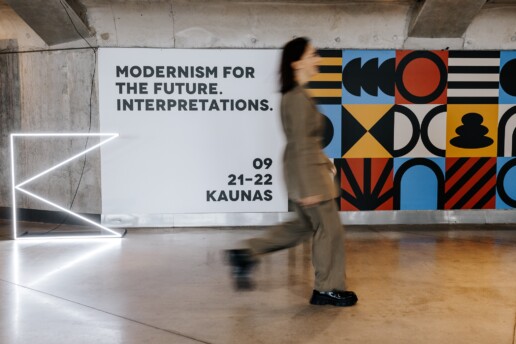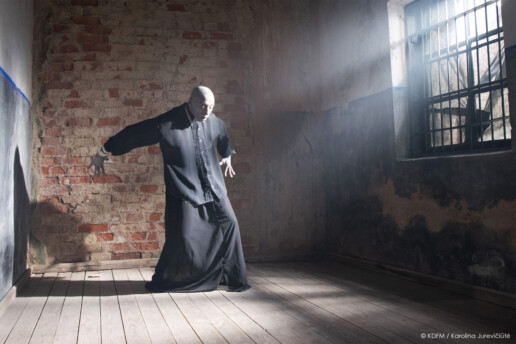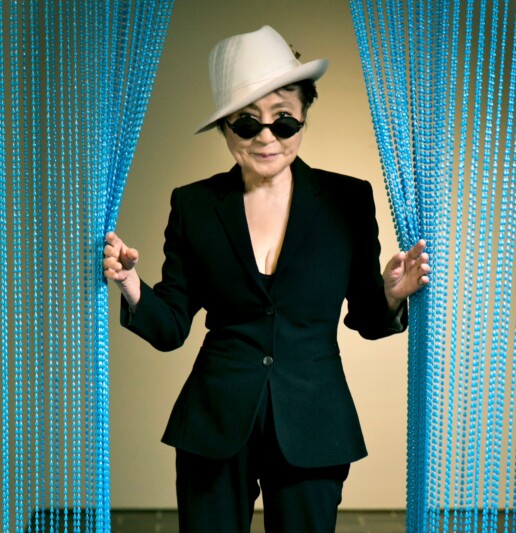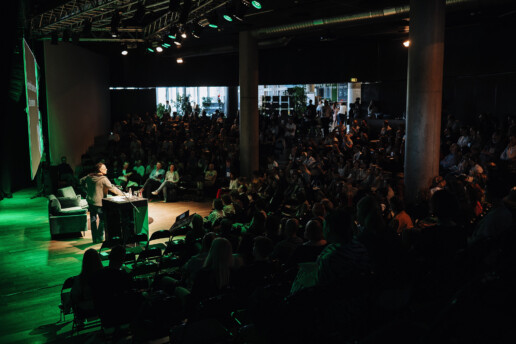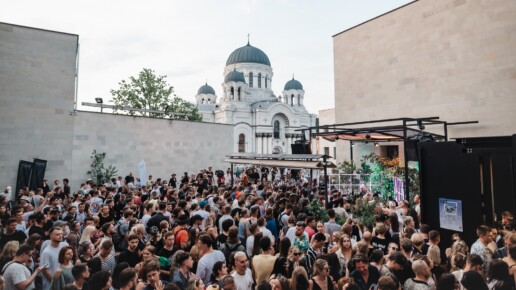“Kaunas – European Capital of Culture 2022” Programme Concludes: Key Figures and Future Plans Revealed
2022-12-07News,Announcements,media-news,Pranešimai spaudai
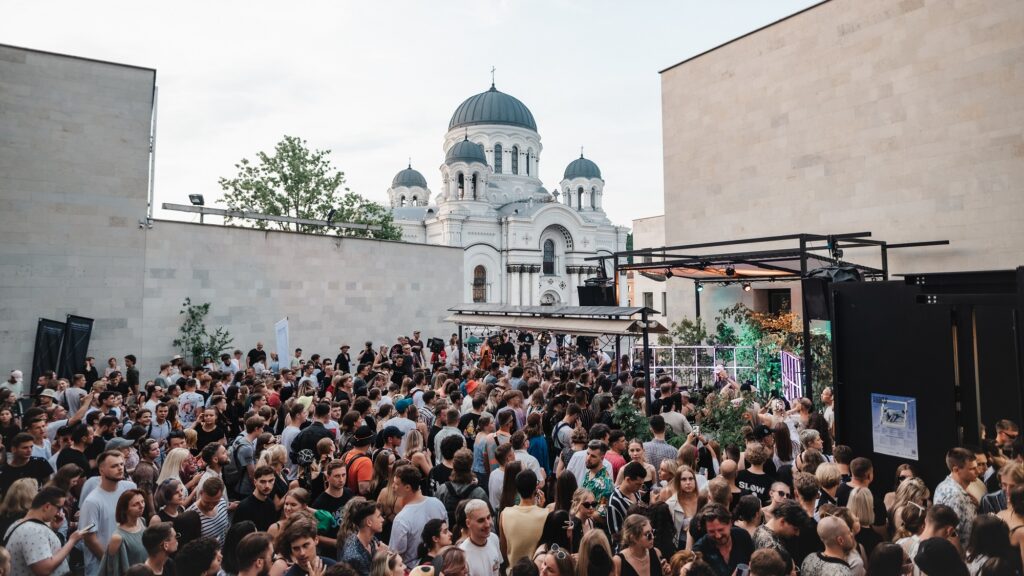
Having attracted 2.4 million visitors in 5 years, “Kaunas – European Capital of Culture 2022” can be hailed as a success story. A programme which has delivered over 3000 events to guests from all over the world, increased tourism, international media attention, and a huge number of participants – these were some of the major achievements and legacies of the Capital of Culture that were discussed by the Lithuanian Minister of Culture Simonas Kairys, “Kaunas 2022” CEO Virginija Vitkienė, and the Head of Communications and Marketing Mindaugas Reinikis at the last “Kaunas 2022” press conference held on Monday.
The journey of “Kaunas 2022” from a temporary capital to a contemporary one began back in 2015 with the preparation of the application for the European Capital of Culture competition. In March 2017, it was revealed that Kaunas’s proposed programme had convinced the selection panel of independent experts, and the city was awarded the title of European Capital of Culture, the EU’s most important cultural project, for the year 2022.
“I expected it to be sad when the title-holding year came to an end, but today I feel that many great things are only just beginning, and how they move forward will depend entirely upon us,” said the Republic of Lithuania’s Minister of Culture, Simonas Kairys, in his opening remarks. According to Kairys, 2022 has been an extraordinary year that has changed the rules of the game considerably – the pandemic, the war in Ukraine and other challenges have forced the organisers to look at the project differently and to adapt to the current situation.
“I believe the project’s greatest objective was to make everyone realise that we are part of the European cultural scene: that it is important to create opportunities for dialogue and international cooperation, and to be open-minded. [...] This title reminds the rest of the world that we have been a part of Europe for centuries, that even after 50 years of being stuck in a dark and difficult tunnel, today we are back in the European family,” the Minister of Culture said.
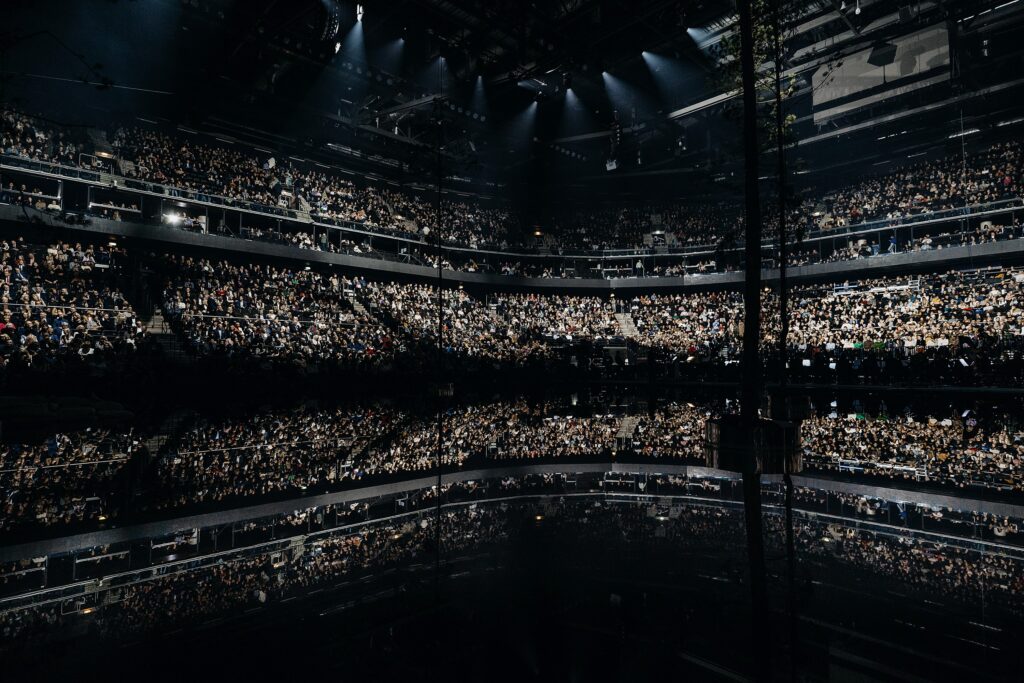
Record Numbers of Visitors and Artists Involved
Over the five years of the project’s implementation, according to Virginija Vitkienė, CEO of Kaunas 2022, 2.4 million culture lovers have attended a variety of events – festivals, concerts, exhibitions, performances, contemporary dance performances and other artistic initiatives. Over half of them visited events in 2022.
19,000 artists and creators from all over the world – Europe, Japan, the USA, South Africa, Israel, and elsewhere – contributed to creating the Capital of Culture in Kaunas and Kaunas District. Yet most of the events, 70 percent, were created and implemented by Lithuanian artists. In 2022 alone, Lithuanian and international artists organised 1,600 cultural initiatives open to the public in Kaunas and Kaunas District.
A total of 26 million euros has been earmarked for European Capital of Culture projects, or 13 euros per person over five years. More than 50 donors and partners contributed to the cultural initiatives, with a total value of 2.8 million euros in financial support and services.
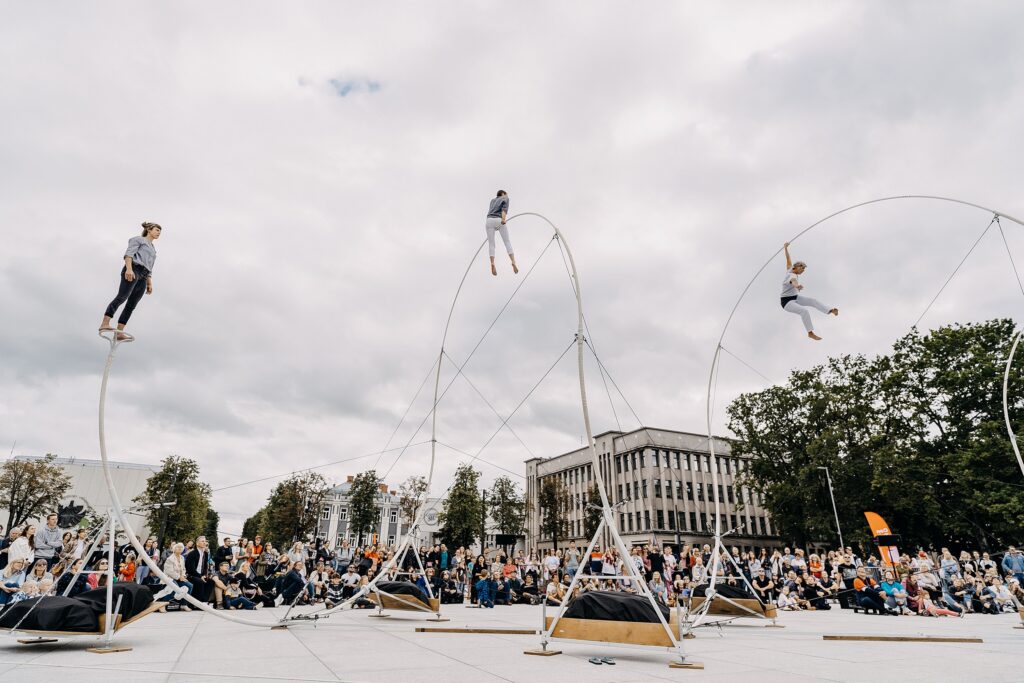
From the BBC and The Guardian to National Geographic
The head of the initiative, Virginija Vitkienė, emphasised that the Kaunas 2022 project gained visibility not only in Lithuania, but also worldwide – in 66 countries in total in Europe and beyond, including the US, India, the United Arab Emirates, Canada, South Africa, South Korea, and Singapore. Over 170 foreign journalists visited the city.
National Geographic, a popular science magazine boasting 6 million readers, noted that Kaunas is “finally getting the plaudits it deserves.” The Telegraph reported that “in Kaunas, the Twenties are roaring once more,” while The Guardian listed the Capital of Culture among the 10 best European city breaks with a difference.
Kaunas has also been covered by the BBC, CNN, The Times, Rai, Deitsche Welle, Financial times, Euronews, and other news sites. It is estimated that news about Kaunas 2022 has reached more than 3 billion people worldwide. Foreign media representatives were attracted not only by the ongoing events, but also by street art, the themes related to memory, Kaunas modernist architecture, and the appearances made by world-renowned artists.
According to Mindaugas Reinikis, Head of Communications and Marketing, “Kaunas has now appeared on maps where it has never featured before, but this will probably take a few decades, or even centuries, to be fully grasped and appreciated.”
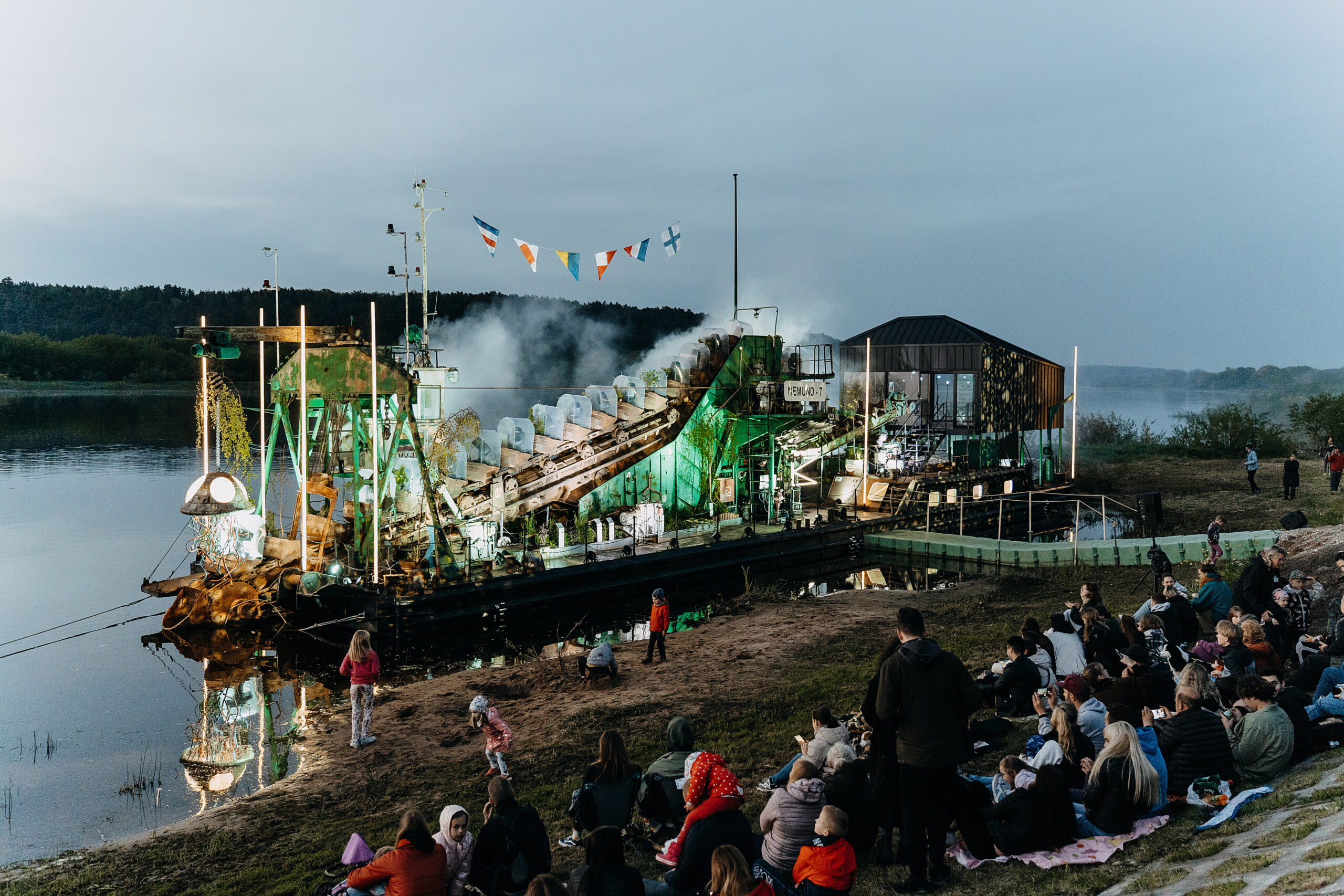
Tourism Boost
International press attention and high-profile artistic events and exhibitions have led to an increase in tourist visits. In 2022, Kaunas accommodated stays from over 309,000 tourists, the majority of whom were from Germany, Italy and neighbouring countries – Poland, Latvia and Estonia. It was pleasing to see that increasingly more people were choosing Kaunas for more than a single-day trip, spending a whole weekend or a few days in the city.
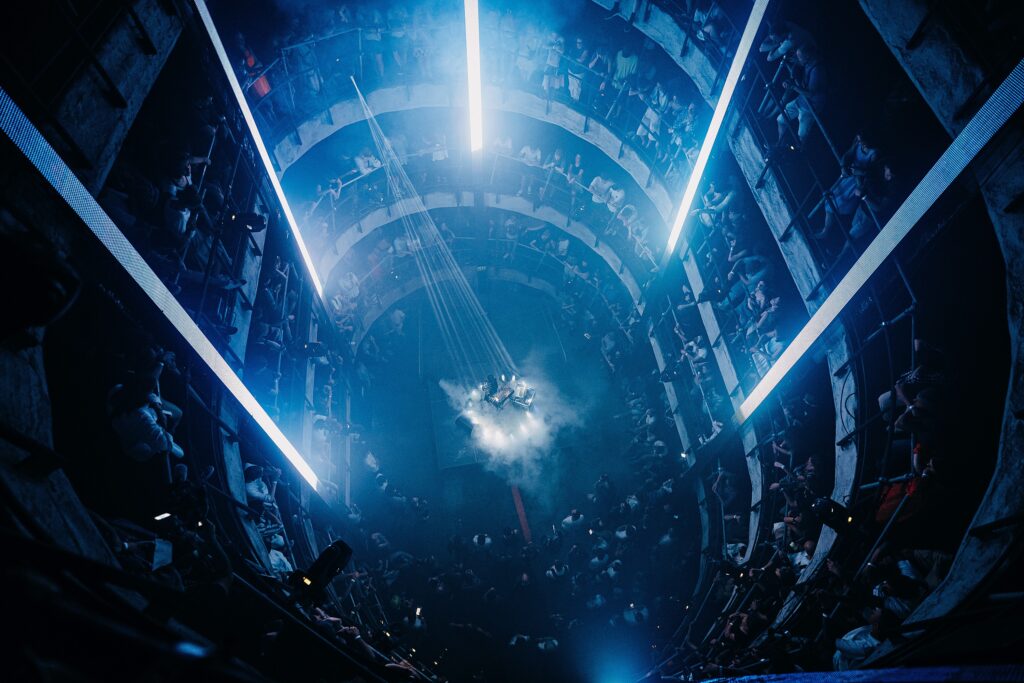
From New Cultural Spaces to Festivals Turned into Traditions
A number of popular festivals and events have become an integral part of the city and its surrounding district. The International Day of Happiness, Kaunas Literature Week, and the Fluxus Festival, which has now become a tradition, will continue to attract visitors and residents of the city. Culture to the Courtyards, Citytelling Festival and the international performing arts festival ConTempo will keep on bringing music and performances to Kaunas’s neighbourhoods. Design enthusiasts will remain warmly-welcomed participants at the MAGENTA Landscape Design Festival. The European Capital of Culture Forum and the much-loved Contemporary City Festival AUDRA will also carry on. And in Kaunas District, the community project “Contemporary Neighbourhoods” will continue to take place.
The CulturEukraine co-working space, launched in 2022, will continue to run its activities in the city, as well as the Kaunas Central Post Office, which has now been transformed into an exhibition venue and event space. The Kaunas Airport, which was renamed as the Kaunas Fluxus Airport, and the sculpture of the Mythical Beast of Kaunas, beloved by children, will serve as reminders of this historic year. Over 1,000 artworks, sculptures and publications created in recent years are going to be exhibited in various art institutions across Kaunas and Kaunas District.
A Path of Emerald, the route touring public art objects, featuring 50 works by Lithuanian and international artists, will remain in operation in Kaunas District, as well as the dredger-boat “Nemuno 7,” located in Zapyškis, now turned into a space of art and culture.
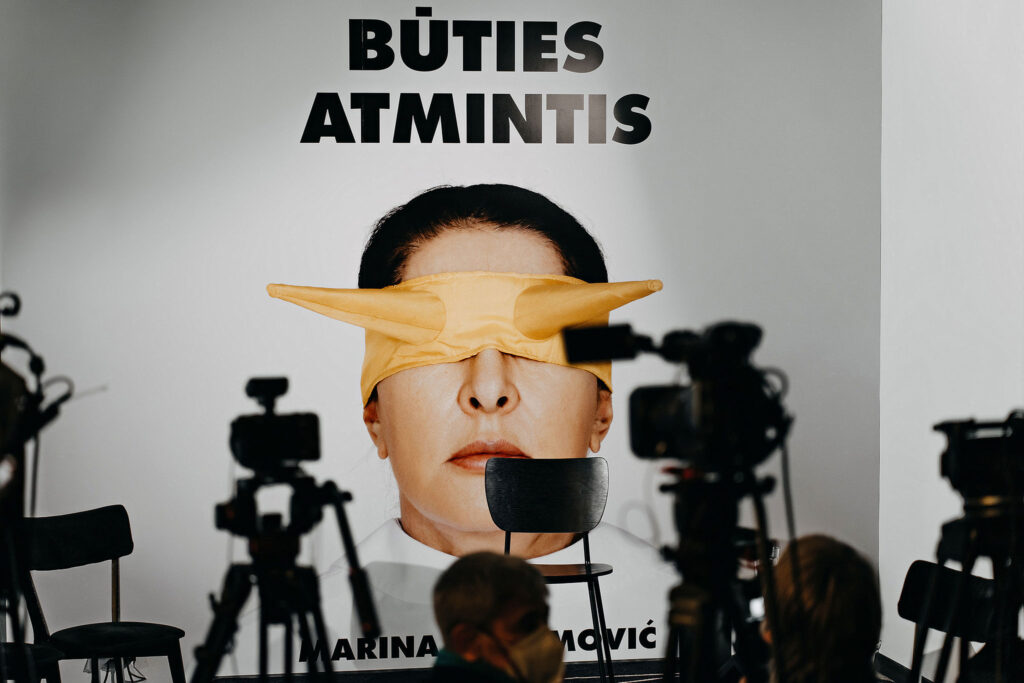
The Capital of Culture Bids Farewell with 2022 Kisses
The most important component of “Kaunas – European Capital of Culture 2022,” as Virginija Vitkienė, the Head of “Kaunas 2022,” points out, is the people who have contributed to this project: artists, representatives of the cultural scene, communities, volunteers, and partners, transforming Kaunas into one big European stage.
As Kaunas passes on the title of Capital of Culture to three other European cities, it bids a symbolic farewell by sending 2022 kisses to Lithuania, Europe and the rest of the world. From the very beginning in 2017, photographer Remis Ščerbauskas has been seeking to capture snapshots of the participants of the Capital of Culture events, community members, artists, Kaunesians and the city’s visitors, volunteers, the project’s implementation team, and all those who have often stayed away from the limelight. All these people had been pouring their energy into taking the city’s culture to a new level in the run-up to the title-holding year.
“Each European Capital of Culture is unique and exceptional. Still, it is gratifying to receive positive comments, for example, suggesting that Kaunas has made the European Capital of Culture project fashionable once again. You will certainly be hearing more from us in the future.” The press conference ended on a high note.
“Kaunas 2022” Closing Weekend: Kaunas is Forever
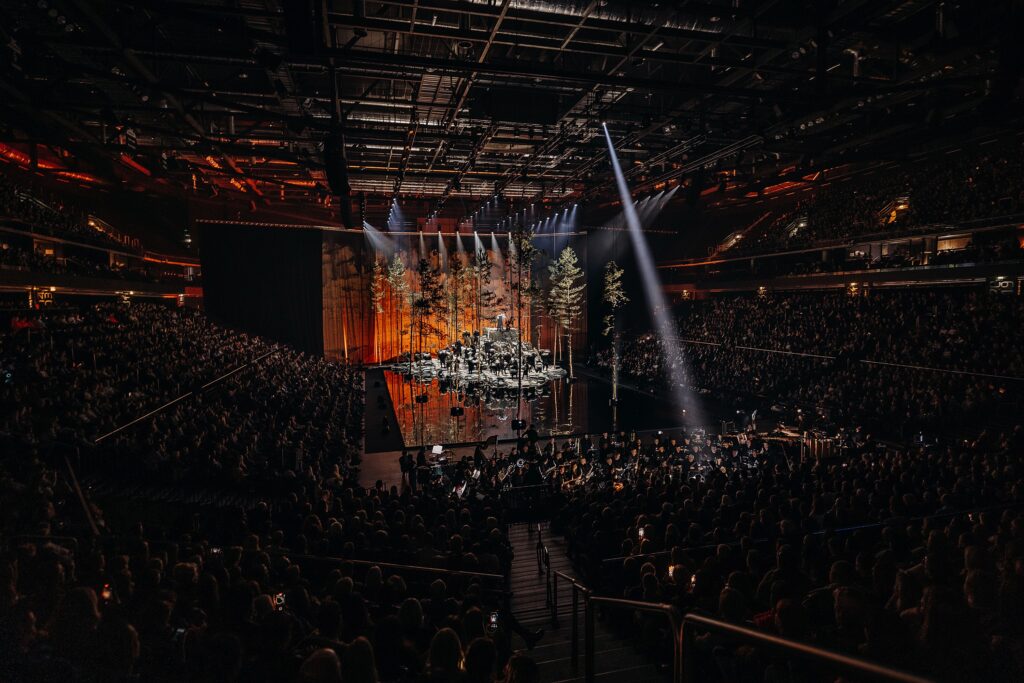
The results of the last official weekend of Kaunas as the European Capital of Culture can be counted in dozens, hundreds and thousands. The intersecting routes of events and happenings, the collecting of the stamps of the Kaunas Beast game and the sharing of promises to take care of yourself and the city, the handshakes and hugs, the shining eyes and the lights of the phones, the final chords of the “Contract” at Žalgirio Arena - Kaunas and Kaunas district were flooded with the hope that after a spectacular year-long programme, the positive, motivating and nurturing relationship with oneself and one’s environment, in which culture is the key element, will not vanish.
Europe’s focus on Kaunas
“Many think that culture is just for fun. However, it is the foundation of our society and soul, an integral part of life. I personally believe that the European Capitals of Culture tradition is one of Europe’s most successful programmes, creating a sustainable positive effect. Culture teaches, transforms, gives hope and perspective, inspires unity and solidarity,” Romanian President Klaus Iohannis said on Friday morning. Together with the leaders of Lithuania, Latvia and Poland, and Ukraine’s president Volodymyr Zelensky, who joined online, he opened the international symposium “The Idea of Europe”. The gathering of intellectuals - academics and practitioners - at Vytautas Magnus University was the most solid event of the “Contract” weekend. Its weight and depth of debate proved the importance of one of the continent’s smallest countries and the city that has this year been awarded the most important title in its life and has withstood global challenges with the title’s help.
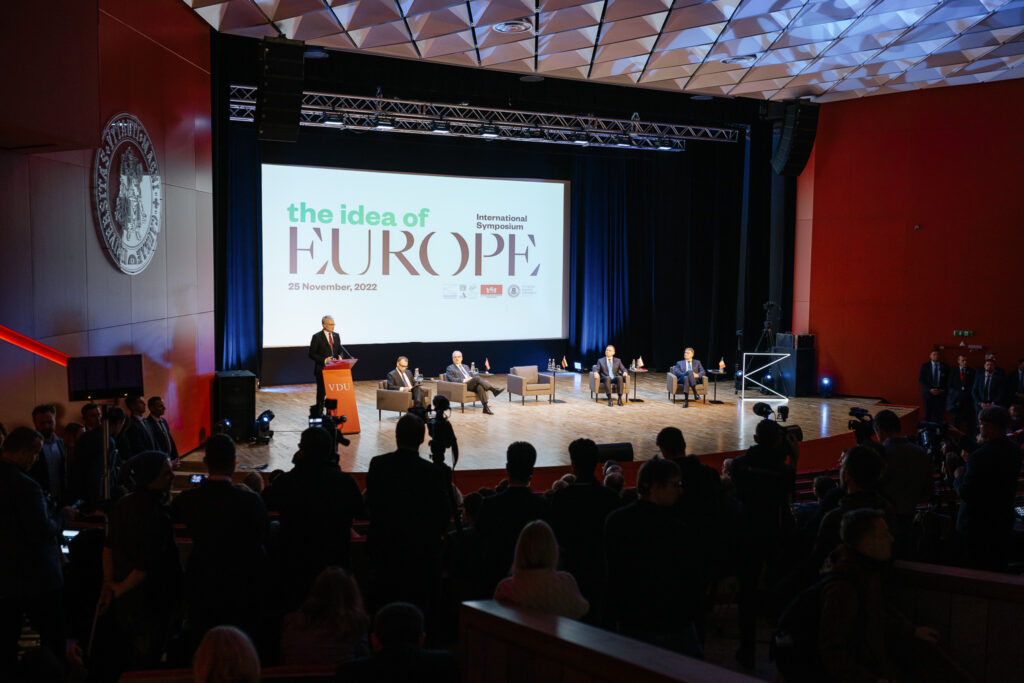
Nurturing Sounds of Music
From the Lithuanian Youth Jazz Orchestra’s resounding debut concert and a bouquet of Yiddish songs at the Kaunas Artists’ House, the choral and experimental music event Deserts in the mysterious Kaunas Waters Reservoir, the tabalai experiment in the garden of the War Museum, the avant-garde electronic performances at the Daina cinema, and the nightclub Lizdas - music lovers were spoilt for choice throughout the European Capital of Culture’s extended finishing weekend. An impressive concert was also held in the Kaunas district - on Friday, Raudondvaris was turned into an open-air dance floor by the performer “Ten Walls”.
Of course, the most impressive sound fabric was created on Saturday evening at Žalgirio Arena - “Contract”, written by composer Zita Bružaitė for the occasion, was performed by singers Jeronimas Milius and Monika Pleškytė, Kaunas Big Band, Kaunas Wind Orchestra “Ąžuolynas”, Giunter Percussion and others, conducted by the talented Ričardas Šumila. The combined forces of dancers led by Petras Lisauskas, including Nuepiko, ULNA, and Šeiko Dance Company, as well as emerging talents, created magic for nearly 9,000 spectators.
The “Contract” was created by: author of the artistic concept and composer Zita Bružaitė, librettist Daiva Čepauskaitė, director Gediminas Šeduikis, set designer Sigita Šimkūnaitė, costume designer Sandra Straukaitė, choreographer Agnija Šeiko, head of the choir Danguolė Beinarytė, lighting designer Andrius Stasiulis, conductor Ričardas Šumila.
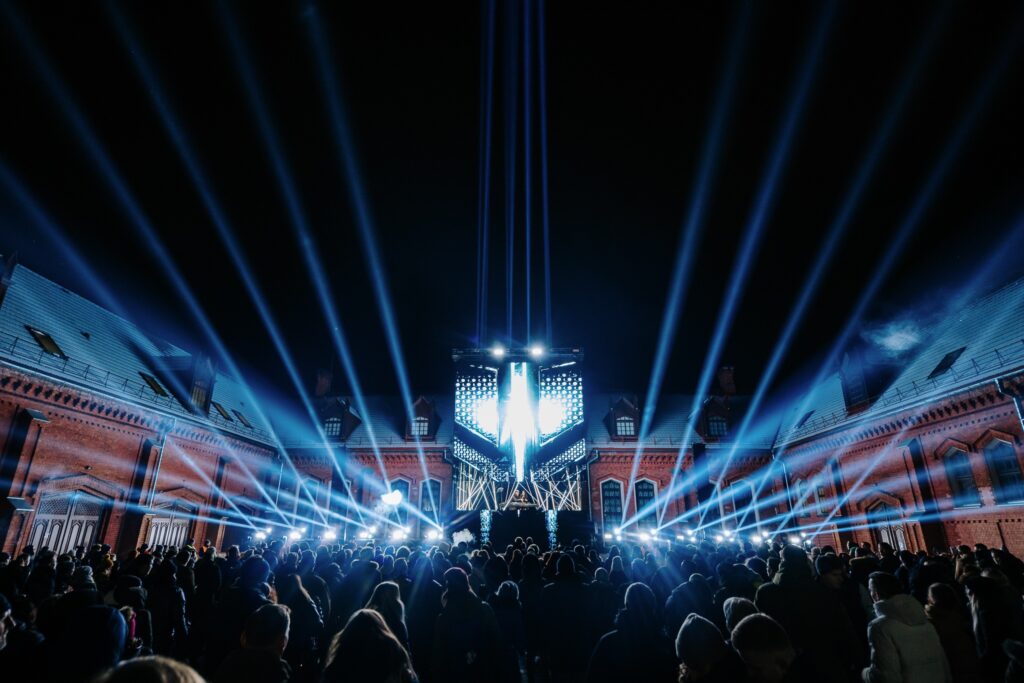
Opening and Closing of Exhibitions
The “Contract” weekend saw the opening of a bunch of exhibitions that will continue to welcome visitors. Ultrasocial Pos by the colourful Polish- Luxembourger Filip Markiewicz is open until New Year’s Day at the Meno Parkas gallery and, in the neighbourhood of the latter, the Kaunas Photography Gallery it’s a must to see an excerpt from The Family of Man, an exhibition presenting the origins of humanist photography that has travelled the world. The Lithuanian Artists’ Union gallery Drobė invited the spectators to look at the fake news from the artists’ point of view in the former textile factory in Šančiai. The photography exhibition “Hiding Places of the Mythical Beast”, which revealed the basements and dungeons of modernist buildings on Vienybės Square, promises to attract the attention of the curious throughout the festive period, most effectively after dark.
The attendance records were also broken by Yoko Ono’s exhibition “The Learning Garden of Freedom” at the Kaunas Picture Gallery, the contemporary art triennial UKRAINE! UNMUTED at Kaunas Central Post Office and William Kentridge’s “That Which We Do Not Remember” at the National M. K. Čiurlionis Art Museum. The international shows, all counting their last days, were explored by both individual guests and guided tours. Meanwhile, Kaunas Modern Art Foundation offered an exclusive itinerary to places important to artists who worked in the city.
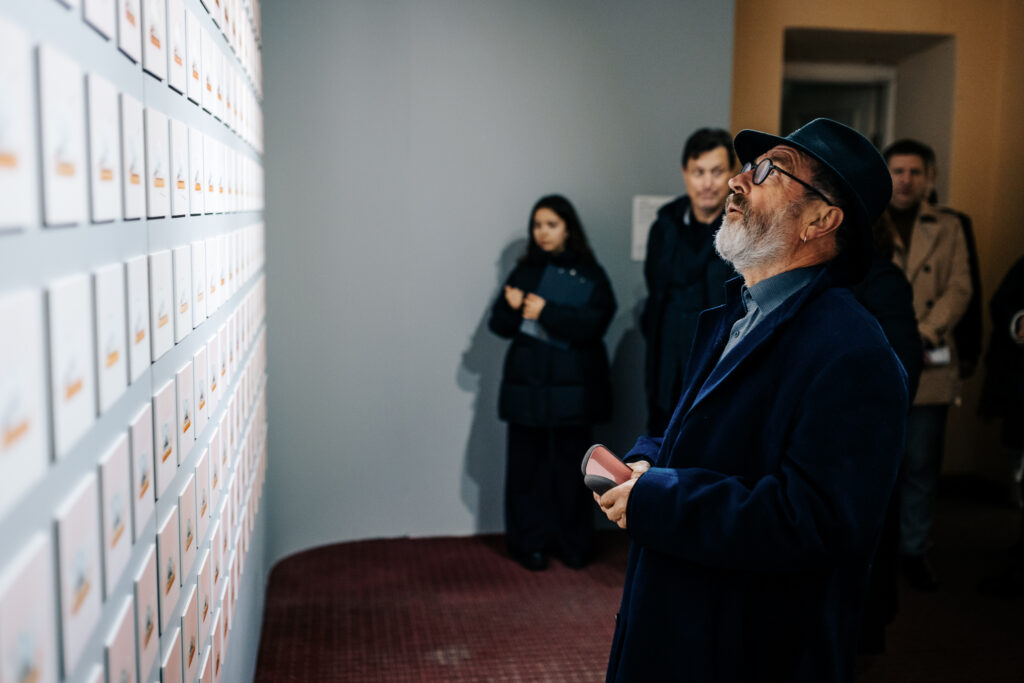
Installations Dispelling the Darkness
The impressions of the “Contract” weekend, which were all over the social networks, were very often filled with art installations in both Kaunas and the Kaunas district. From the city centre, where many cultural institutions and other buildings came together for one spectacular light spectacle, to a narrow street in the Old Town, transformed into an artistic “Artery”; From the installation "Process" in Independence Square, which made everyone pause, to the stairs to the Mythical Beast’s lair, which appeared in the 1st Fort of Kaunas Fortress just for this weekend - all the artistic accents underlined that Kaunas is not only a beautiful city but also a city that wants to be happy in the future.
A contract with Oneself
The most important souvenir of “Kaunas 2022” a contract signed with oneself and the city - was taken home by almost 4000 participants of the closing weekend. Just as during the first two acts of the Kaunas trilogy, “Confusion” and “Confluence”, people followed rules and collected stamps provided by colourful characters waiting at the game stops.
Every city is beautiful. Every city is a city of love. Every city is like Kaunas and Kaunas is like every city. Every city has suffered in the past. Every city wants to be happy in the future. People we know are good people. People we don't know are good people. People we don't understand are good people. My freedom depends on the freedom of others. Kaunas is forever. These points in the „Contract“ reminded everyone to take care of themselves, others and the city.
The signing ceremony of the “Contract”, which was not only visually spectacular but also personally dedicated to each individual, took place hundreds of times in a wishing-washed underpass by the river Nemunas. And, of course, in the hearts and minds of everyone who has lived through Kaunas’ transformation “from temporary to contemporary”. After all, as the last clause of the “Contract” proclaims, Kaunas is forever.
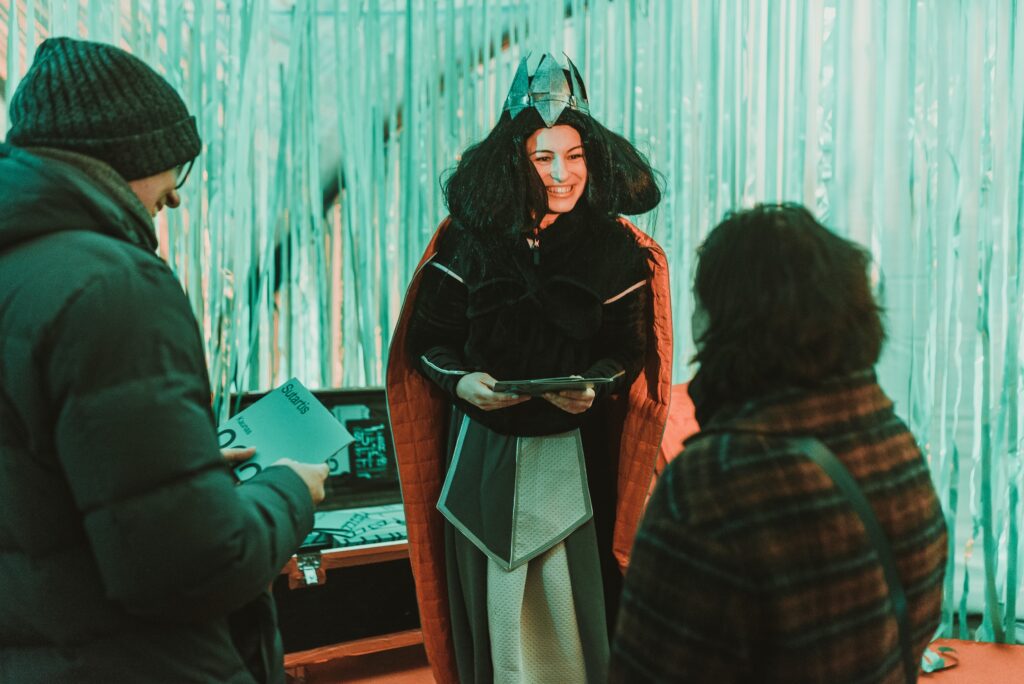
November events in Kaunas. What not to miss?
2022-11-04Current Issues,Announcements,Pranešimai spaudai
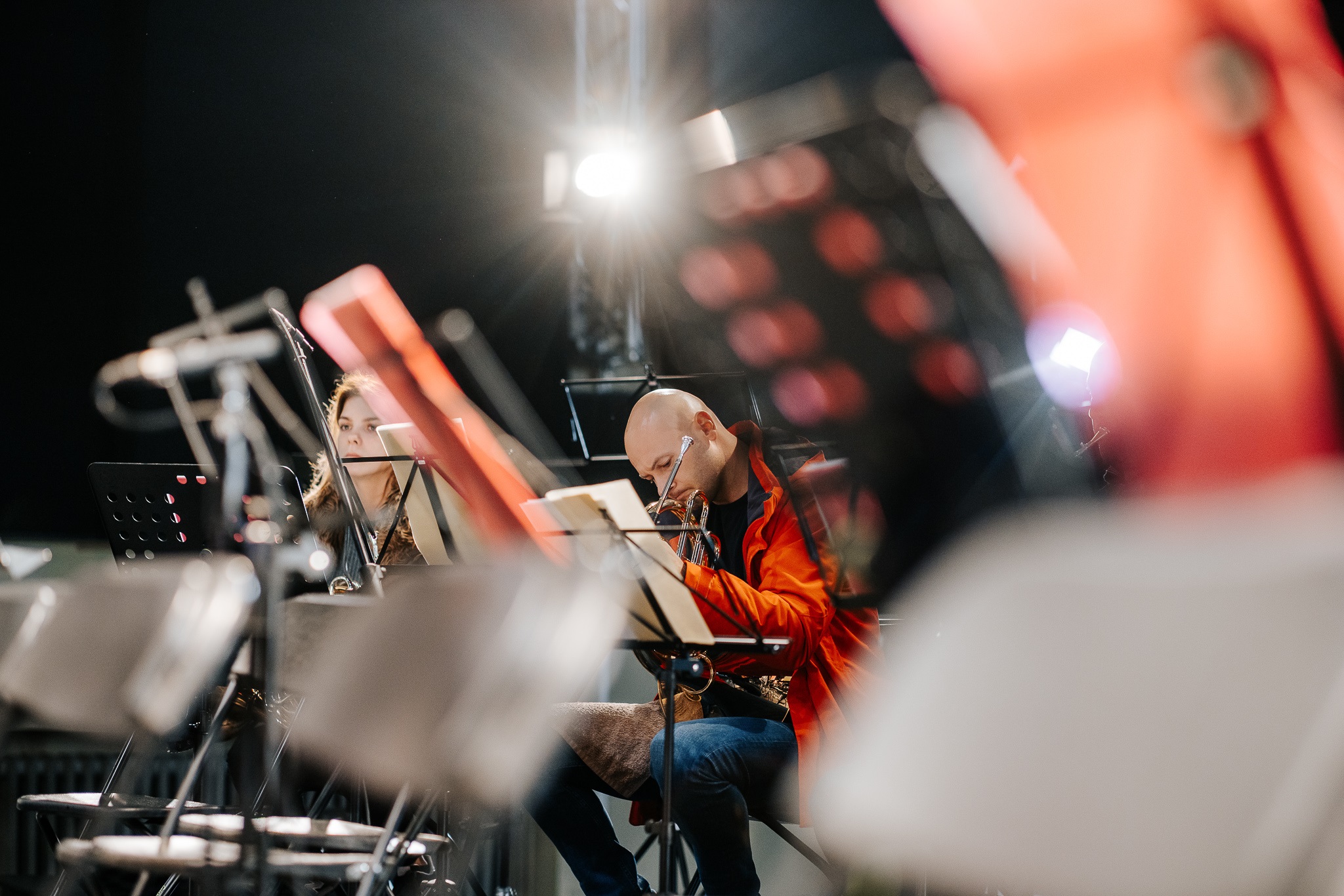
The last month of autumn in “Kaunas - The European Capital of Culture 2022” is marked by special experiences. New exhibitions, music and theatre premieres await in the city, while the final events of the month will invite you to immerse yourselves into a grand closing program “The Contract”. “Kaunas 2022” shares recommendations on what to see and what not to miss as the year of the European Capital of Culture draws to a close.
The triennial of Ukrainian contemporary art “Ukraine! Unmuted”
Already on November 4th, “Kaunas - the European Capital of Culture 2022” welcomes the 5th triennial of Ukrainian contemporary art “Ukrainian Cross-Section 2022. UKRAINE! UNMUTED”. The triennial will present an exhibition, a performance, public discussions and a book of essays. All the events attempt to disclose what Ukrainian art was and what it is now, letting the art speak for itself. This year, the main exhibition of the triennial will present 17 artworks by Ukrainian artists from Dnipro, Kherson, Kyiv, Kharkiv, Lviv, Odesa and Donetsk. The exposition will invite visitors to discover video works, installations and objects, paintings, graphics, and photography works.
When: Until December 4
Where: Kaunas Central Post Office
More information is available here.
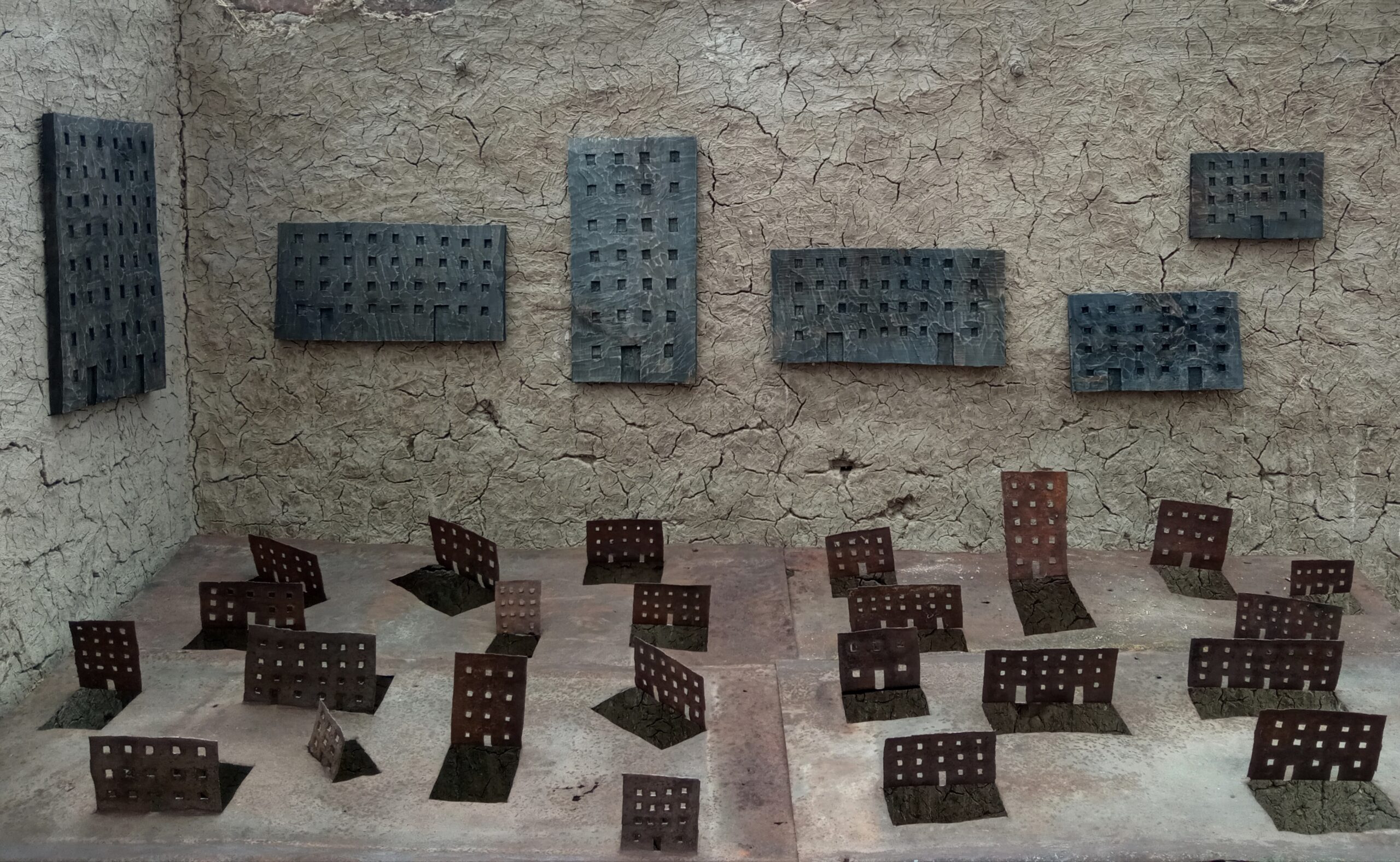
“Protecting Layer”, aut. Konstiantyn Zorkin“Carrying the Light”. Symphony dedicated to Chiune Sugihara
As a Japanese consul in Lithuania during World War II, Sugihara rose above the terror of the Nazi regime by risking his life and career in saving 6.000 Jews who were fleeing Europe. On November 5th, this story will be remembered in the language of music by Kaunas State Choir, Kaunas City Symphony Orchestra, cello virtuoso Kristina Reiko Cooper and conductor Konstantinas Orbelianas, who will present a special musical programme “Carrying the Light”.
When: November 5
Where: Kaunas State Philharmonic
Tickets are available here.
Exhibition „Working Class Heroes“
Freedom, power, money, and human rights – these are the universal themes explored by the first Work Museum in Luxembourg (MUAR/ Musée van der Aarbecht). In a rather contemporary way, the exhibition “Working Class Heroes” presents three working-class heroes Jean-Pierre Bausch (1891–1935), Léon Weirich (1878–1942) and Jean Schortgen (1880–1918). Personal stories of the people who created Luxembourg, a small country in the middle of Europe, raise relevant questions anew: who created your country, who represents your rights today, and how far have we progressed in the field of labour law?
When: Until 2023 February 23
Where: Kaunas Picture Gallery
More information is available here.
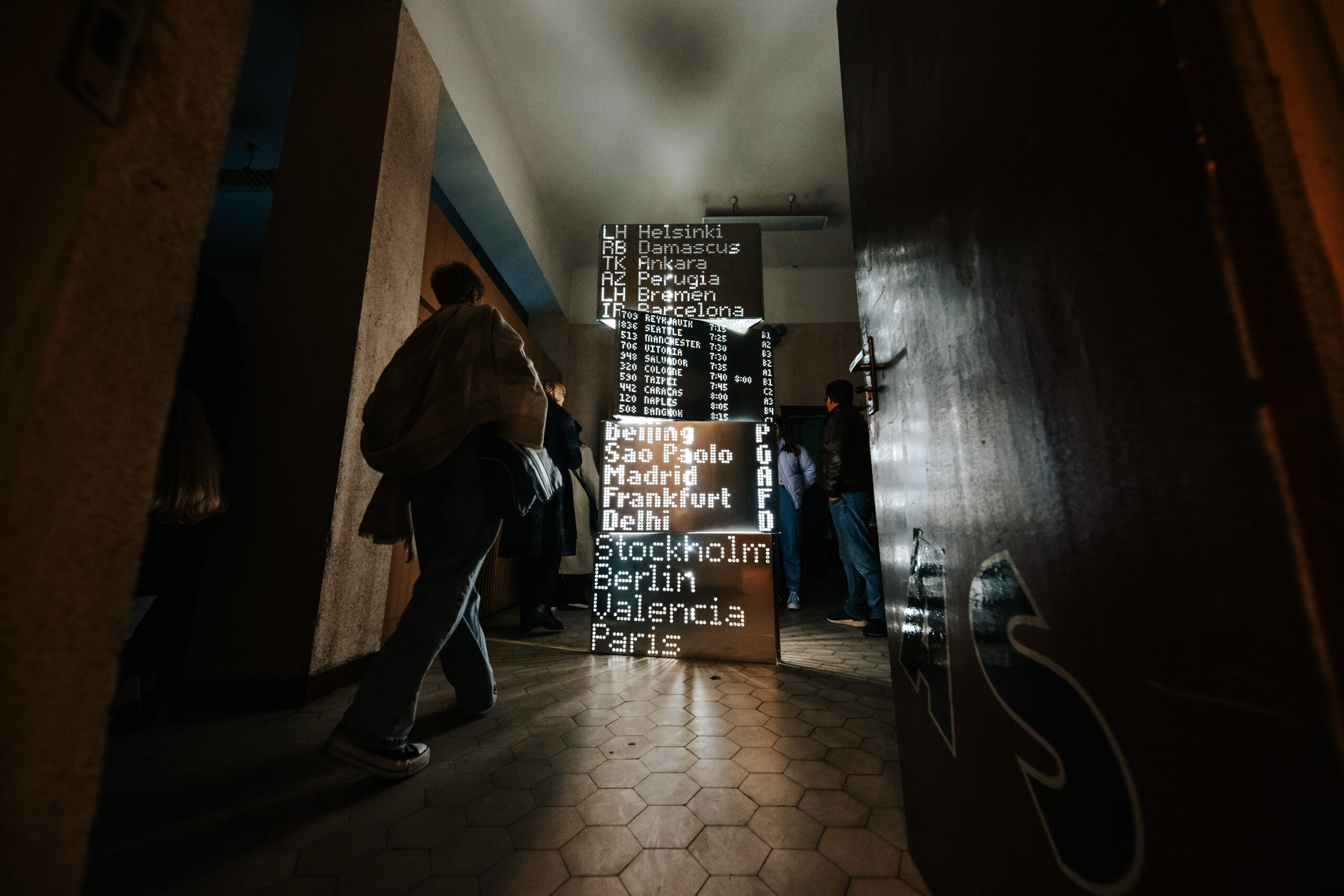
International symposium “The Idea of Europe”
The recent decades' geopolitical, international, cultural, and mental changes make it a pressing issue to ask again, what do we mean when we say ‘Europe’? European and world intellectuals, scientists, artists, and politicians will meet at the two-day event to answer this question. The presidents of Lithuania, Poland, Romania, Latvia, and Estonia will participate in the symposium. The symposium is under the patronage of the President of the Republic of Lithuania Gitanas Nausėda.
When: November 25-26
Where: Vytautas Magnus University
More information is available here.
The Assembly Kaunas
Performance the “Assembly Kaunas” is a joint creative project of the Kaunas National Drama Theatre and the documentary theatre Porte Parole (Canada). By using theatrical means, the project aims at creating a democratic dialogue on topics that greatly divide our society. During the creative process of the performance, the creative team invited 4 strangers with different ideological views to a dinner in which they discussed the topics greatly polarising our society. In the performance, you will see the re-enacted discussion: the actors will play real people, who have participated; their language will be authentic and not edited. The Assembly Kaunas is an aspiration to restore our faith in the possibility of change.
When: November 25, 27
Where: National Kaunas Drama Theatre
Tickets are available here
Yoko Ono’s retrospective exhibition “The Learning Garden of Freedom”
The Learning Garden of Freedom is a retrospective exhibition of Yoko Ono’s work organised in collaboration with Studio One in New York, founded by the artist herself, the Contemporary Art Centre in Vilnius, and the Kaunas Picture Gallery in Kaunas. The exhibition presents an overview of Yoko Ono’s works, including various creative periods and practices ranging from conceptual art and experimental films to spatial installations, objects, and performance art.
When: Until 4 December
Where: Kaunas Picture Gallery
More information is available here.

OSTRALE contemporary art exhibition. „Streams upstream“
The OSTRALE Biennale in Dresden is one of the largest contemporary art exhibitions in Germany, organized in non-traditional spaces, initially designed for purposes other than art. “Streams upstream” is the final OUT of OSTRALE event, completing the series of European cultural cooperation project “Flowing connections”. This is an exhibition about globality and all the nowness, unfulfillments and subtexts of this multi-layered phenomenon.
When: Until November 13
Where: Kaunas Central Post Office
More information is available here.
“Kaunas 2022” closing program “The Contract”
The journey of “Kaunas - European Capital of Culture 2022”, which has given more than 1,500 events and initiatives, is slowly coming to an end. At the end of autumn, the organizers are inviting you to the last adventure - the 4-day long year-closing program “The Contract’. November 24-27 Kaunas and Kaunas district will invite you to a free concert of the “Ten Walls”, numerous events, exhibitions, and the grand closing performance in the “Žalgiris” arena.
When: November 24-27
Where: Various places in Kaunas and Kaunas District
More information is available here.

World premieres and art in non-traditional spaces: the most important October events in Kaunas
2022-10-04Aktualijos,News,Announcements,Aktualijos
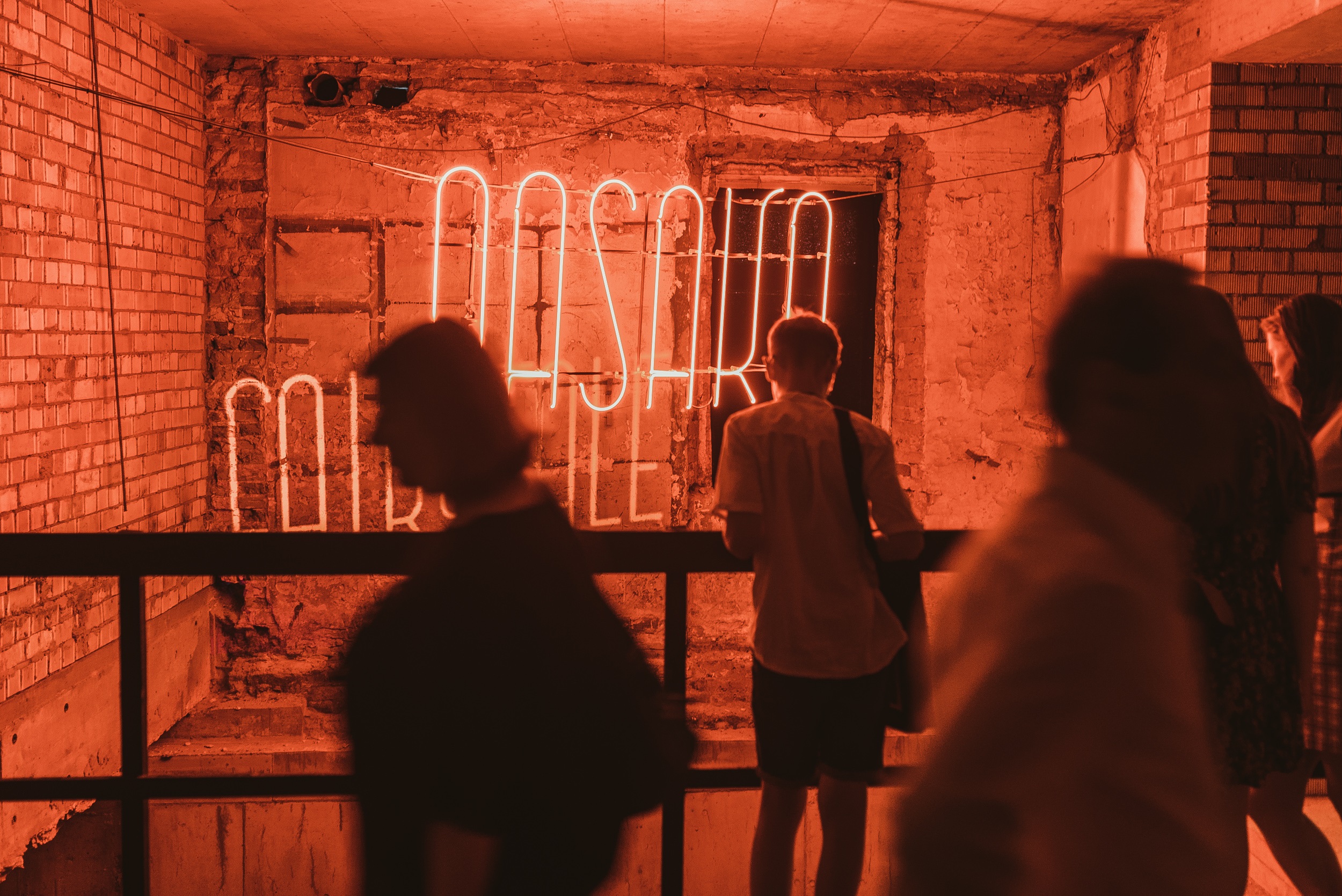
Although the year of the European Capital of Culture in Kaunas is slowly coming to an end, October offers many more inspiring experiences waiting for culture enthusiasts. From design events and exhibitions of world-famous artists to music premieres: “Kaunas 2022” is pleased to share some recommendations on what to see and what not to miss in the autumnal city.
“Woven Art: 20th Century European and American Carpets of the Avant-Garde”
“An exhibition that reveals the spirit of the 20th century through the interwoven synergy of different types of art” - this is how the exhibition “Woven Art: 20th Century European and American Carpets of the Avant-Garde” could be described. The exhibition presents various carpets and collectable furniture created by the world's most prominent artists.
When: 1–14 October
Where: Kaunas Artists’ House
More information is available here.
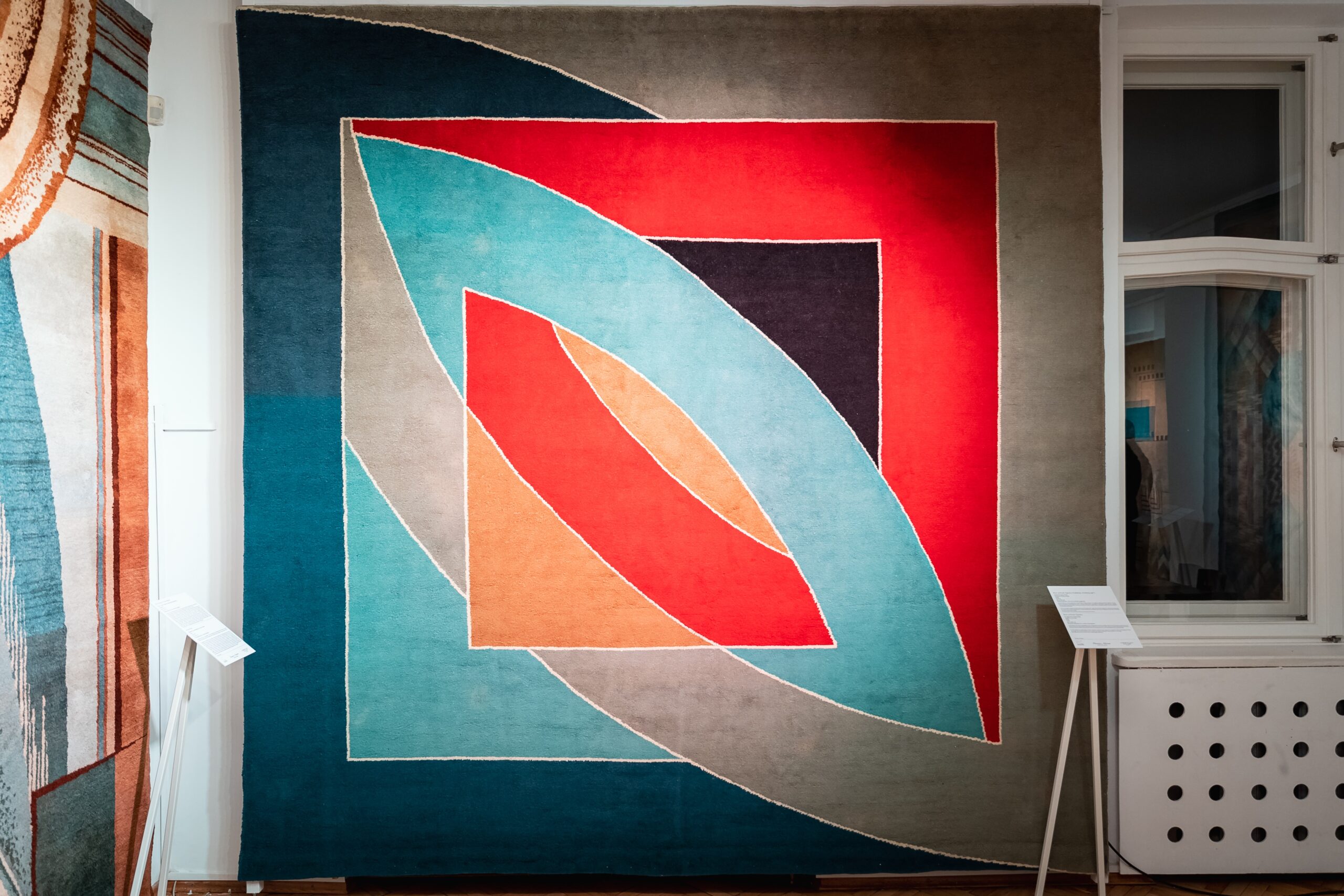
Yoko Ono’s retrospective exhibition “The Learning Garden of Freedom”
The Learning Garden of Freedom is a retrospective exhibition of Yoko Ono’s work organized in collaboration with Studio One in New York, founded by the artist herself, the Contemporary Art Centre in Vilnius, and the Kaunas Picture Gallery in Kaunas. The exhibition presents an overview of Yoko Ono’s works, including various creative periods and practices ranging from conceptual art and experimental films to spatial installations, objects, and performance art.
When: Until 4 December
Where: Kaunas Picture Gallery, K. Donelaičio St. 16
More information is available here.
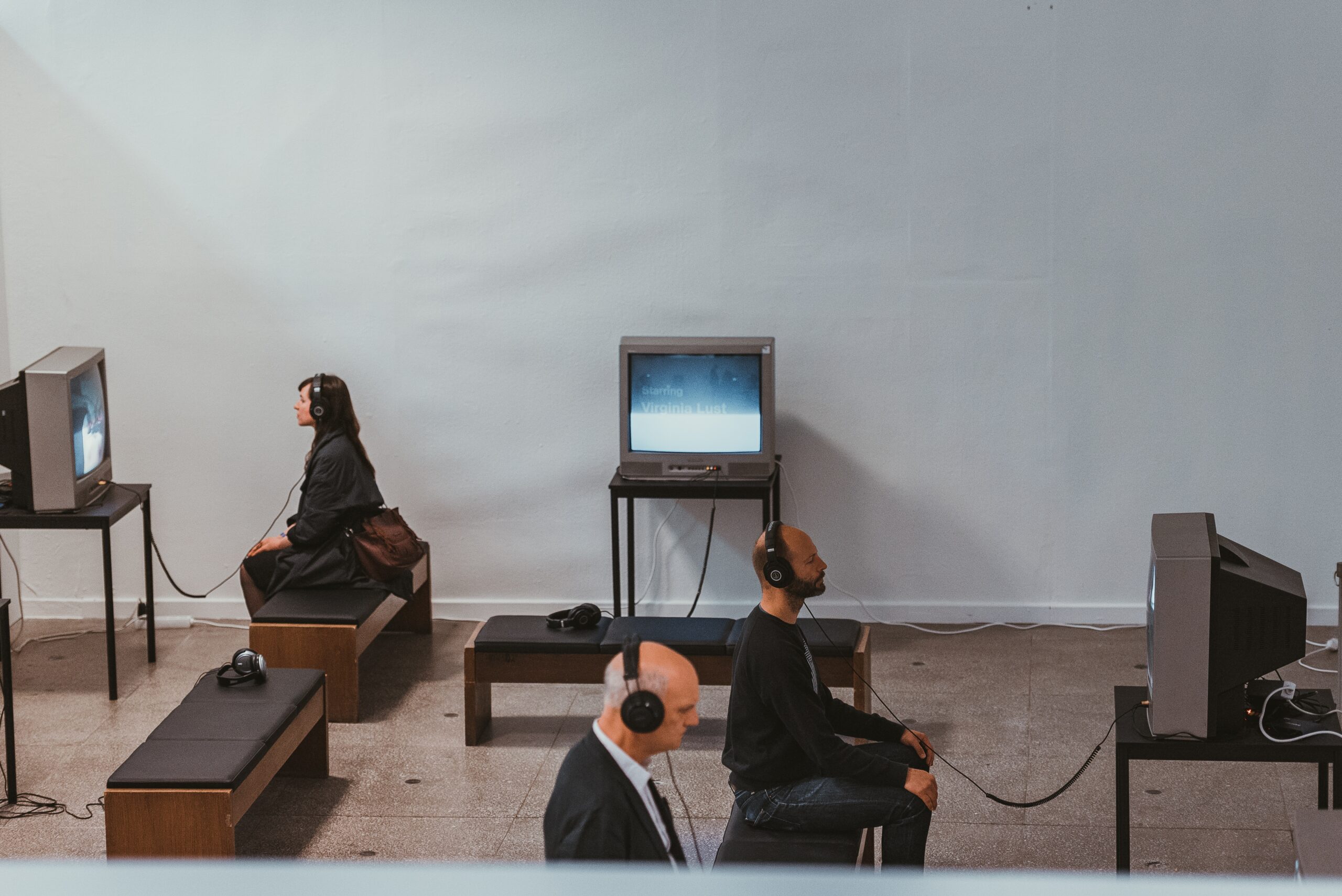
Royal Philharmonic Orchestra concert
Kaunas State Philharmonic Orchestra and Kaunas – European Capital of Culture 2022 present an exclusive international project created with the famous Royal Philharmonic Orchestra and piano virtuoso Simon Trpčeski. The Royal Philharmonic Orchestra, celebrating its 76th birthday this year, is at the forefront of musical life in the United Kingdom (UK), with a mission to enrich the lives of its audiences with the perfect and immersive experience of orchestral music. In the programme: Sergei Prokofiev, Ludwig van Beethoven and Jean Sibelius.
When: 12 October
Where: Kaunas Žalgiris arena
Tickets are available here.
CityTelling Festival. “The Dybbuk”
The CityTelling Festival, aiming to remind the multi-ethnic memory of Kaunas and its surroundings continues and invites to one more premiere. On October 14-15 at the Kaunas cinema centre “Romuva”, the audience will experience a mystical and mysterious event – the musical performance “The Dybbuk”. The performance created by the Kaunas Symphony Orchestra and a group of Israeli actors will combine the fields of music, cinema, and theatre and will tell a love story inspired by Jewish folklore.
When: 14-15 October
Where: Romuva cinema
Tickets are available here.
Forum of International Design Networks
This year, Kaunas can be proud not only of the title of the European Capital of Culture but also of the fact that it is gradually becoming a real centre of the design. This October, for the first time in the country ‘s history, the most important world design organizations will meet in one city. The forum will be attended by such global design networks as the UNESCO Cities of Design Network, ICoD (International Council of Design), BEDA (Bureau of European Design Associations), and EIDD (Design for All Europe). The programme will feature several conferences, workshops, and meetings.
When: 14 October
Where: Žalgiris arena amphitheatre
More information is available here.
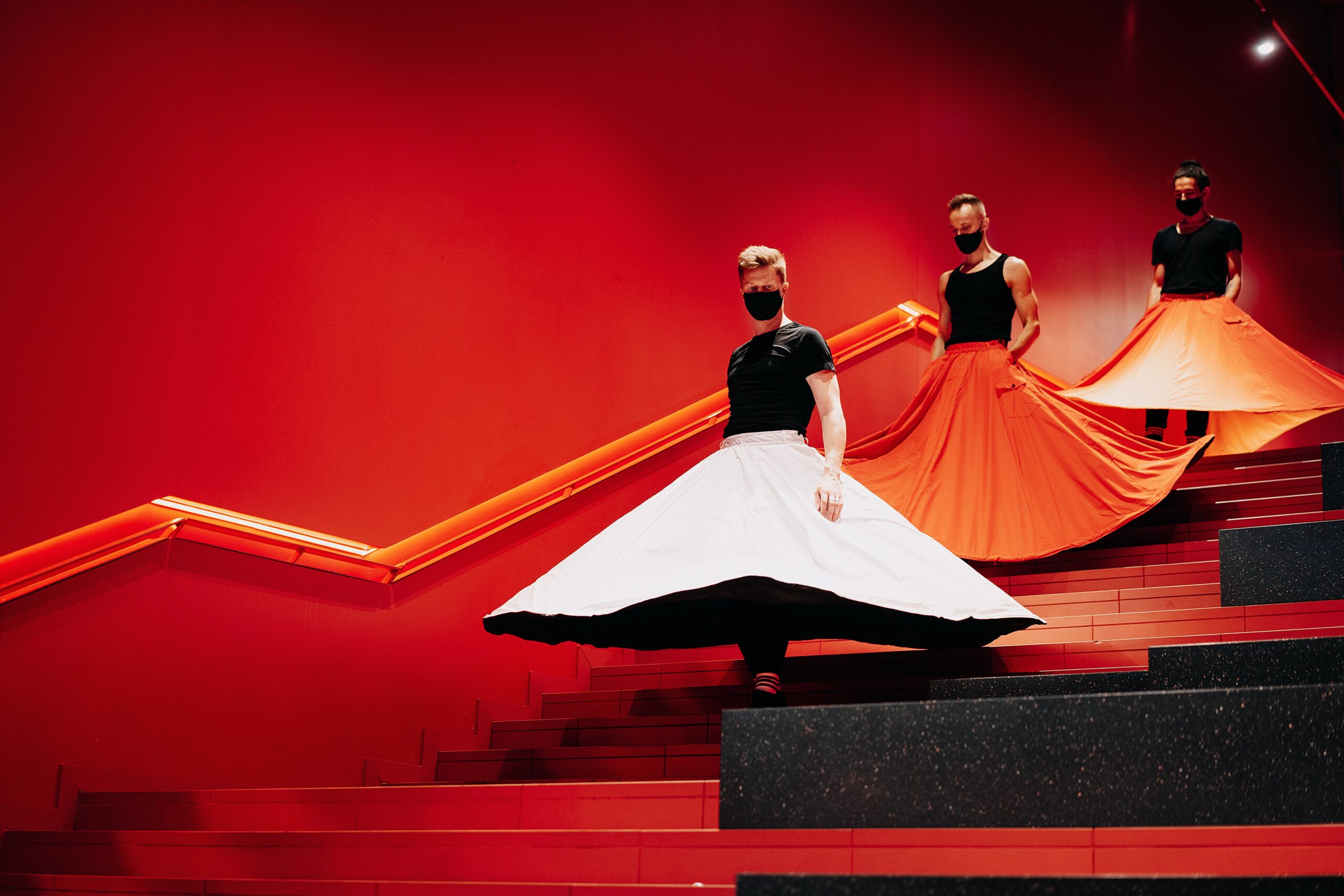
Andrew Lloyd Webber’s “Requiem”
On October 31st at Žalgiris arena, Kaunas City Symphony Orchestra and Kaunas – European Capital of Culture will host a Requiem by Andrew Lloyd Webber, one of the most famous contemporary composers and winner of the prestigious Grammy Award for music. Together with the Kaunas City Symphony Orchestra, the audience will see many well-known performers, including tenor Edgaras Montvidas, soloist Kseniya Bakhritdinova-Kravchuk, and the Kaunas State Choir.
When: 31 October
Where: Žalgiris arena
Tickets are available here.
OSTRALE contemporary art exhibition. „Streams upstream“
The OSTRALE Biennale in Dresden is one of the largest contemporary art exhibitions in Germany, organized in non-traditional spaces, initially designed for purposes other than art. “Streams upstream” is the final OUT of OSTRALE event, completing the series of European cultural cooperation project “Flowing connections”. This is an exhibition about globality and all the nowness, unfulfillments and subtexts of this multi-layered phenomenon.
When: 5 October– 13 November
Where: Kaunas Central Post Office
More information is available here.
Interactive exhibition “Out of Darkness”
Artist Jenny Kagan, daughter of Juozapas Kagan and Margarita Štromaitė from Kaunas, grew up in the United Kingdom, surrounded by stories of pre-war and wartime Lithuania. In the exhibition Out of Darkness, she brings the extraordinary story of her parents’ survival in Kaunas during the Holocaust to life. The exhibition’s setting, including images, music, video projections, and other elements, immerses the viewers in a narrative that is both personal and universal.
When: until 30 October
Where: Gimnazijos St. 4
Tickets are available here.
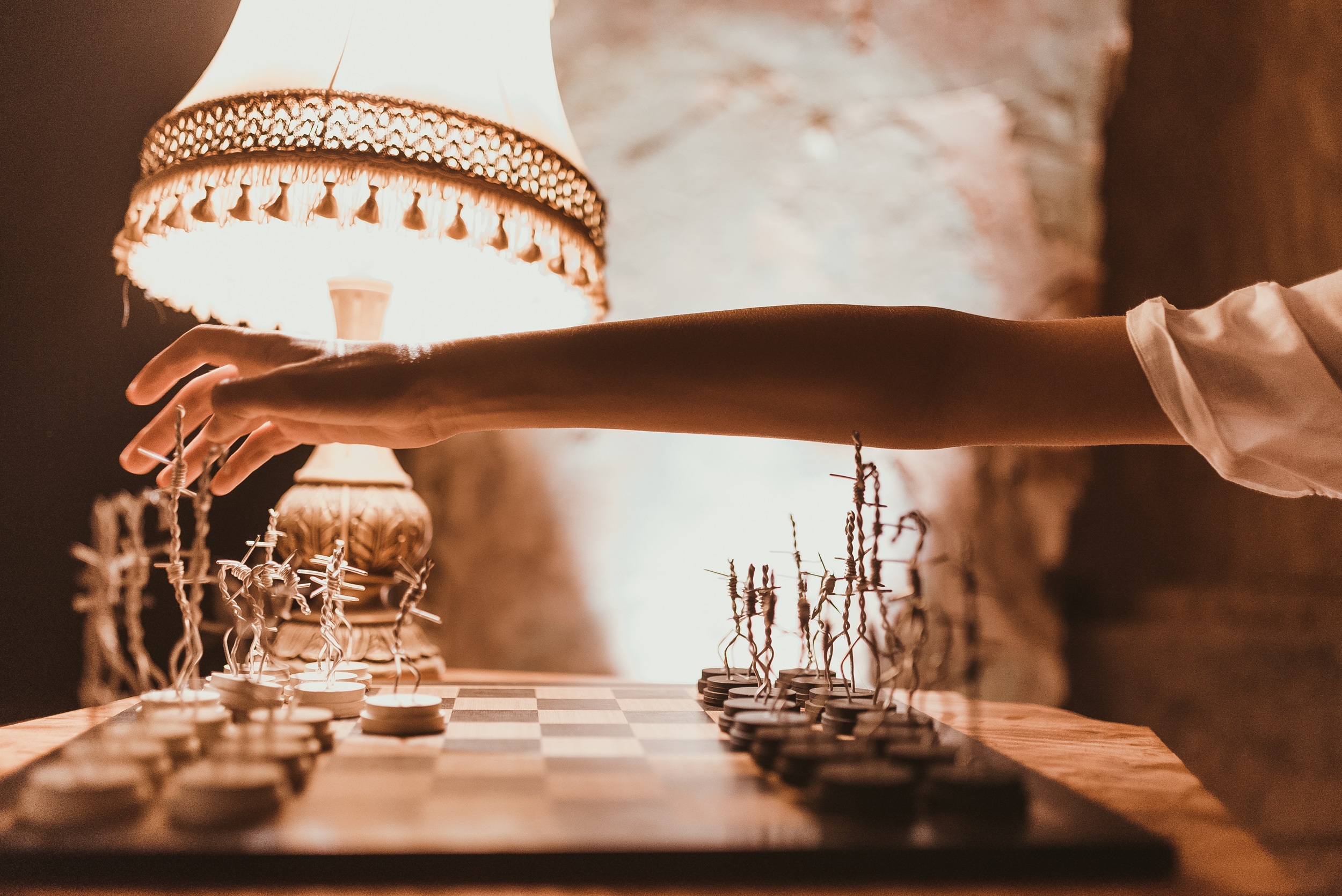
The autumn of culture continues
October events and exhibitions are designed for everyone's taste. A pleasant surprise awaits lovers of porcelain art at the Kaunas Central Post Office - the Exhibition of International Bone China symposium, “the Porcelain City”. Theatre lovers will surely find it interesting to see the performance “Dorian” directed by one of the most famous contemporary theatre figures, artist Robert Wilson. Moreover, the cultural boat “Nemuno7” will complete the series of exhibitions “Fluid Bodies” with authentic interpretations of the theme of ecology. The full Kaunas 2022 programme is available at www.kaunas2022.eu or on the mobile app.
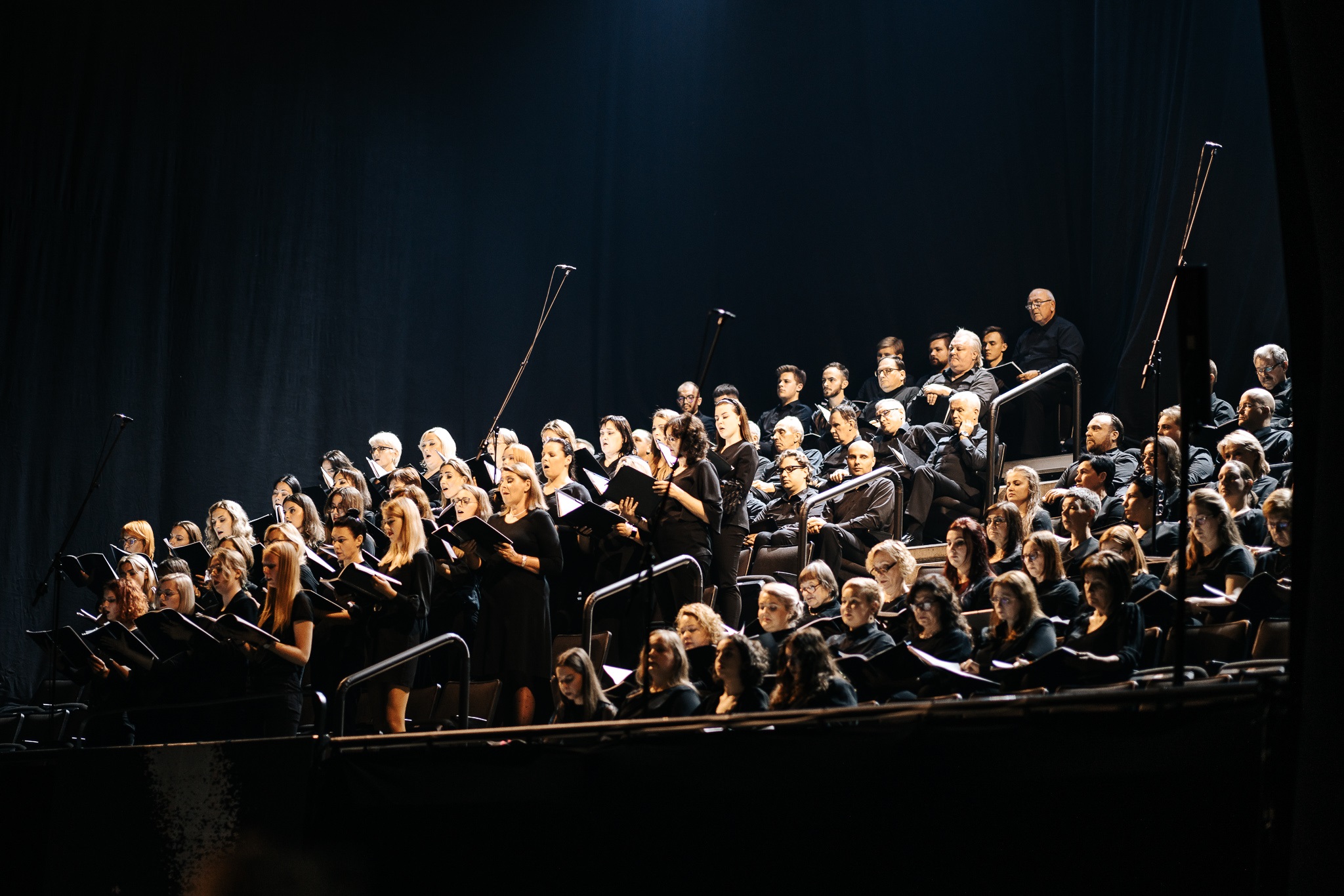
Final Meeting of the “Modernism for the Future” Programme: Multiple Modernities From Kaunas to Manchuria
2022-09-27Uncategorized,Aktualijos,Aktualijos,Pranešimai spaudai

“Architecture is always a dream and a function, expression of utopia and instrument of comfort”, Vaidas Petrulis, one of the organisers of the final conference of the European Capital of Culture’s programme “Modernism for the Future”, opened the event with a quote from the French philosopher Roland Barthes. The event attended by a wide range of thinkers and practitioners to Kaunas offered unexpected ways of talking about the inevitably shared past, present and future of our planet; the history in which architecture plays the role of both antagonist and protagonist.
“Multiple modernisms”. Uta Pottgiesser, professor at Delft University in the Netherlands and head of DOCOMOMO, the international organisation that documents and conserves the heritage of modernism, was the first to use this term to describe an era that has touched the entire planet. The two words became the leitmotif of the day.
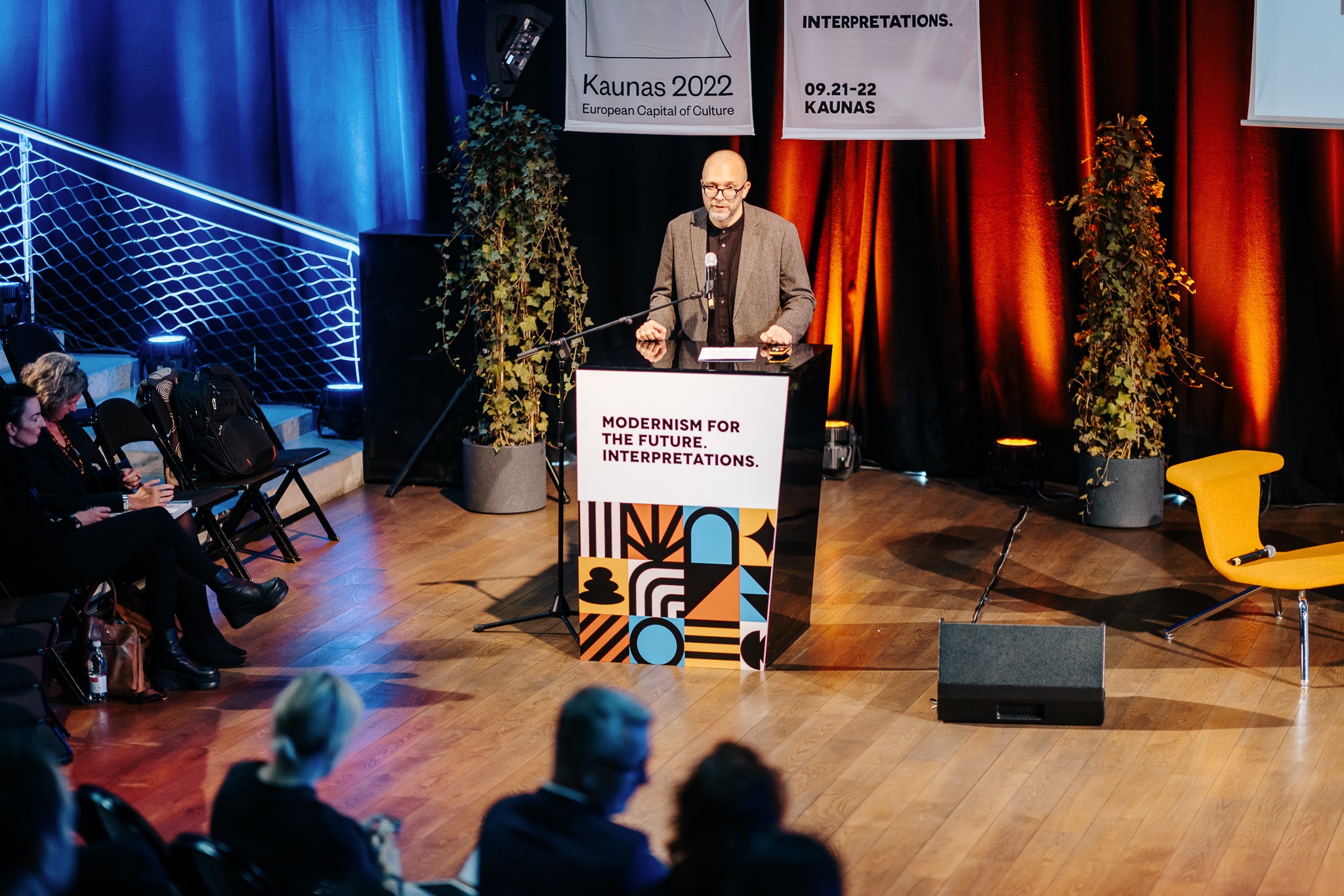
Inspiration is not Only in Buildings
The subtitle of the second edition of the conference was “Interpretations”. Aideen Barry, an Irish artist working with communities worldwide on socially engaged art, opened the programme with a presentation of her stop-motion animation film, “Folds/Pleats”. Its premiere was held on the inaugural night of the conference at the historic Romuva cinema. The two-year-long artistic chain of events was full of coincidences, as well including hours-long workshops on Zoom during the quarantine, iconic Kaunas modernist buildings becoming dancers’ costumes and edible cakes, as well as hundreds of Kaunas residents of all ages who joined the process. The film, inspired by early cinema and animation created behind the Iron Curtain, has already been presented around the world. It is not a documentary but a freely interpreted history of the modern city and the people who created it, enticing even the viewer who has never heard of Kaunas before.
At 3 am New York time, artist, architect and conservationist Jorge Otero-Pailos joined the event in Kaunas. His online talk on art as a way of care and dust and other traces of time in architecture as inseparable layers of its layers received an ovation and was quoted in subsequent presentations. After presenting his project “The Ethics of Dust”, in which the cleaning of the surfaces of historic buildings becomes a pretext for contemporary works of art, the artist talked about his most famous initiative, which took place in the Norwegian capital. Unlike the modernist masterpiece itself, the fence of the US Embassy in Oslo was not included in the list of protected buildings. Otero-Pailos decided to turn this element, which surrounded the embassy after 11 September 2001, into an independent series of sculptures.
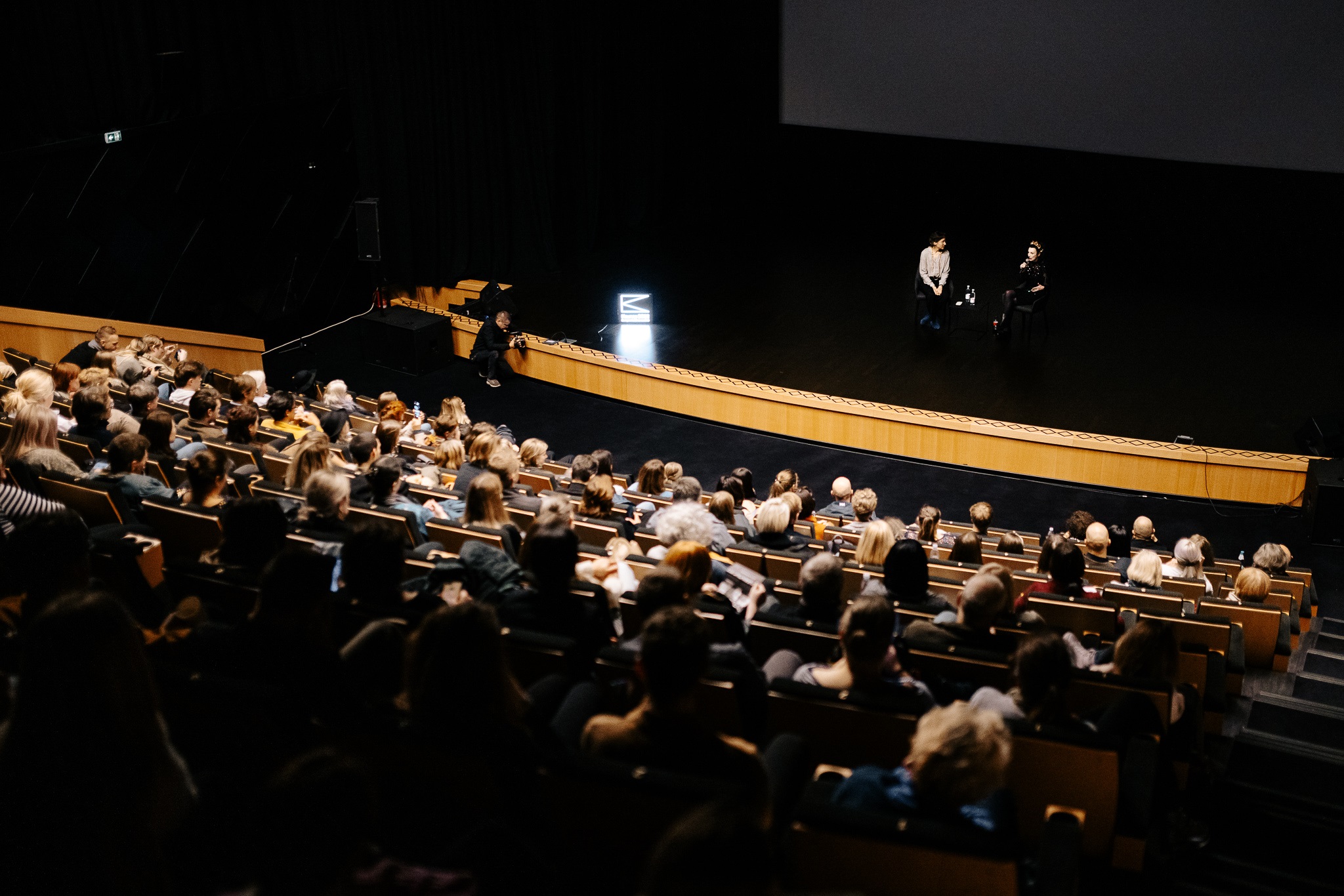
G. Jovaišos nuotr.Subjectivity as a Component of Objectivity
In the afternoon, the conference participants were attracted by a discussion on the concept of subjectivity as an assessment of art, architecture and heritage viewed from different perspectives. Researcher Grzegorz Piątek spoke about the unconditional love of Poles for the interwar period, and thus for the country created at that time, as a breakthrough, a growth, and even a golden age. Contrasting this is the sceptical attitude towards the residential areas, cultural and commercial buildings and other objects that popped up after the Second World War. Paradoxically, the extremely popular Neon Museum in Warsaw only displays the signs of historic buildings, many of which no longer exist today. Lolita Jablonskienė, head of the National Gallery of Art in Vilnius, emphasised the importance of context (or the contexts that have been considered separate until now) in evaluating architecture and art produced in the past decades and the duality of the two. Swiss photographer Nicolas Grospierre, who has been photographing modernist architecture for two decades, spoke of his subjective concept of constructing a narrative through related forms, excluding other factors.
“Mythologizing comes in cycles. It’s interesting to break this cycle, which is possible after defining a set of criteria that could facilitate that break. It is important to look into history objectively as early as possible,” noted Piątekas. “People prefer Stalinist-era because they are better decorated, subjective emotional ties and associative values play an important role here,” added architectural historian Marija Drėmaitė, moderator of the panel.
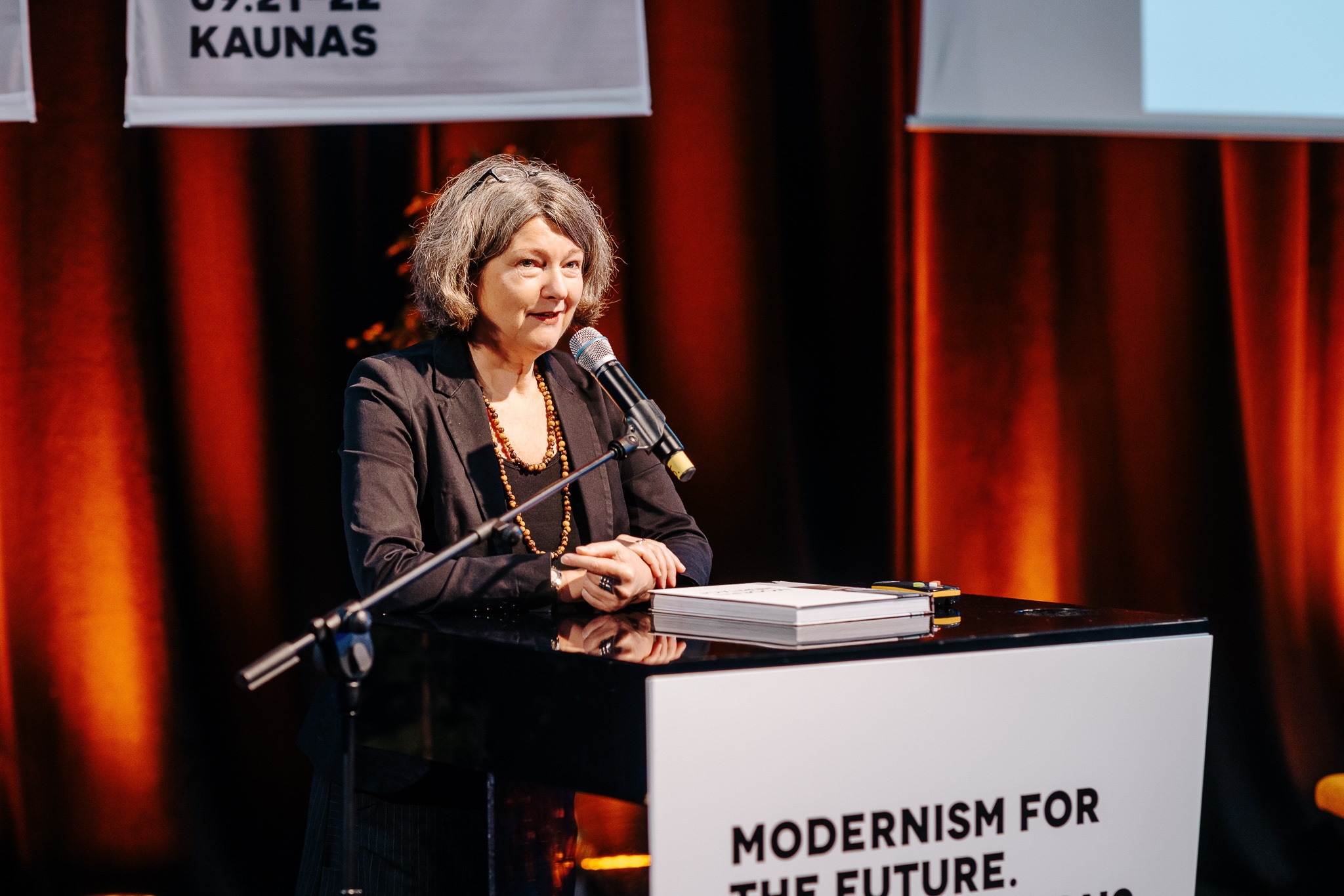
Modernizmo konferencija, G. Jovaišos nuotr.Modernism - a Cause and/or a Product of the Anthropocene?
The heritage of the recent past is paradoxical - it belongs to modernity, but the consequences of modernity pose an existential threat to it. A discussion moderated by Edward Denison of the Bartlett School of Architecture at the University College London (UCL) in the UK invited people to think about modernism as the cause of the current geological epoch. Denison’s colleague Guang Yu Ren presented the Manchuria region in present-day China, a land little known to many present-day Europeans, where modernist cities were planned as early as the late 19th century, as industrial mines were established. In the region, what we consider heritage may, in fact, belong to several nations, including the Russians and Japanese.
The open question of whether the colonists gave anything at all to the African continent, from which they drew their wealth and empires for many decades, and in return imported their way of life, customs and architecture was raised by Maxwell Mutanda of UCL. Linara Dovydaitytė, a scholar at Vytautas Magnus University, presented the object of her research - the nuclear heritage, which is inseparable from the colonial era, as well as the nuclear aesthetics and the interpretation of the industrial heritage in art.
Alessandro Petti online from Sweden presented Decolonising Architecture Art Research, a project he runs with Sandi Hilal. One of their missions is to inscribe the Dheisheh refugee camp in Bethlehem, Palestine, on the UNESCO World Heritage List. Israelis settled in the site of dozens of former villages after 1948. According to Petti, such camps, which are not made of tents but concrete structures, are doomed to permanent temporariness and are built to be forgotten as soon as possible.
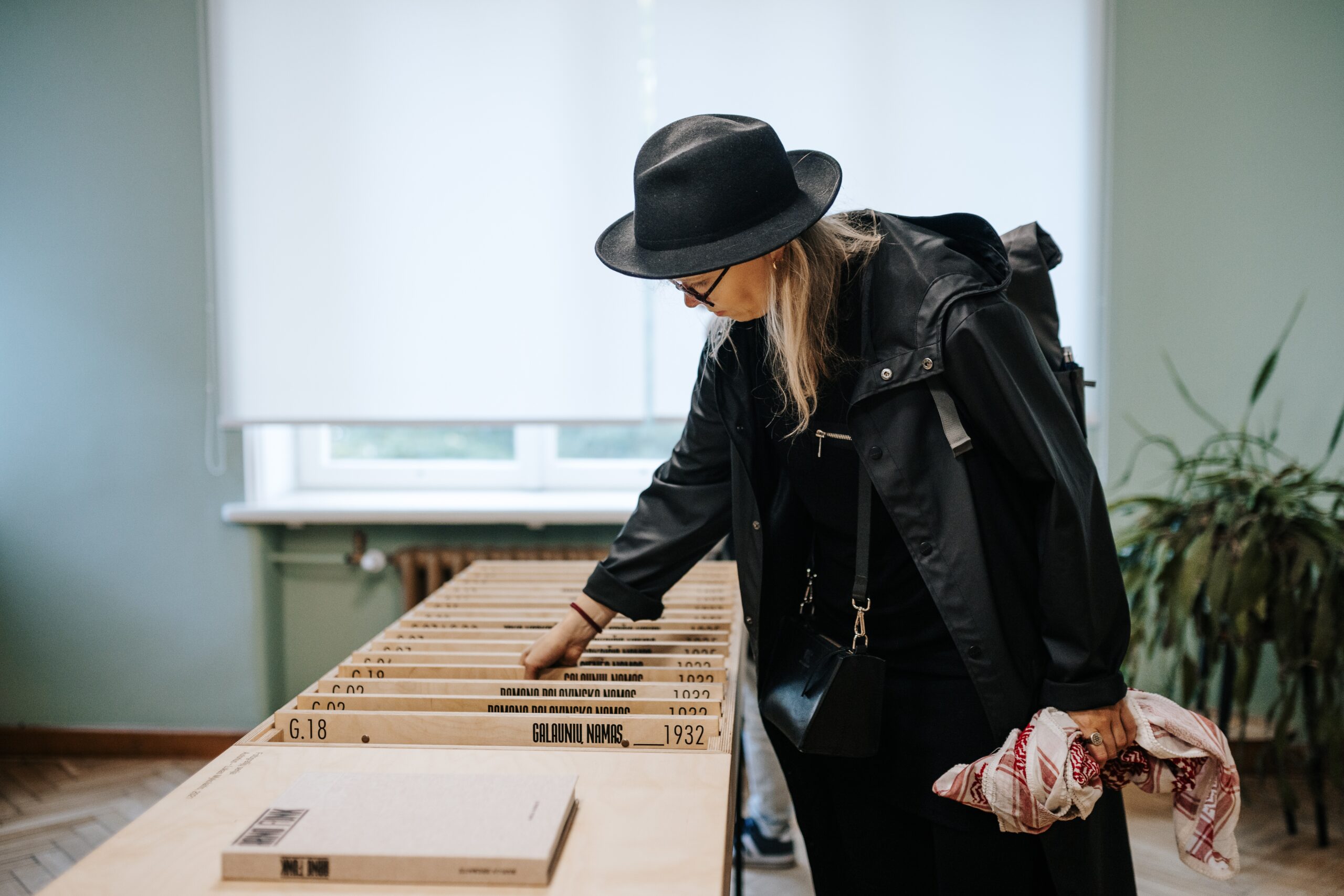
A Dispute about Value - Public or Professional?
“We have spent many years discussing what to do with Soviet apartment blocks. Well, the Russian missiles just destroyed them, so that’s one less question,” Yevgeniya Gubkina, a Ukrainian architectural historian and self-proclaimed architectural activist who hails from Kharkiv, which was severely damaged by the war earlier this year, wryly and very aptly observed. Equally ironic was the British journalist and writer Owen Hatherley, who observed that nobody likes Western leftists coming to Eastern Europe and explaining what Soviet modernism is. Hatherley put forward an equally intriguing theory about the actual Westernness of modern Russian imperialism, reminiscent of colonial powers and their methods.
The debate moderated by Maxime Forest again stressed the geographical and political diversity of modernisms and the absence of a unified public opinion. “Often the debate about what to do with Soviet architecture is only raised by professionals - people are not bothered by it, they are affected by the emotional connection,” mentioned Gubkina. She also reminded us that architecture is just a tool - we do not judge a knife for murder. The thought of architecture and art critic Aaron Betsky, who said: “Buildings don’t talk, so we have to speak for them”, is also relevant here.
Discussions and presentations of the conference “Modernism for the Future. Interpretations” took place on 22 September in the Žalgirio Arena amphitheatre. The recordings and a series of podcasts will be published online. The main conference programme was introduced and followed by additional meetings, exhibitions and other events in various locations in the historic centre of Kaunas. The event attracted architecture and heritage professionals and enthusiasts from a handful of countries. “Modernism for the Future. Interpretations” was the final highlight of the Kaunas 2022 programme dedicated to the actualisation of heritage and curated by Viltė Migonytė-Petrulienė. However, as many conference participants expressed, the international meeting was only an introduction to future joint projects and discussions on multiple modernities.
For the complete Kaunas 2022 programme, please visit www.kaunas2022.eu or the mobile app.
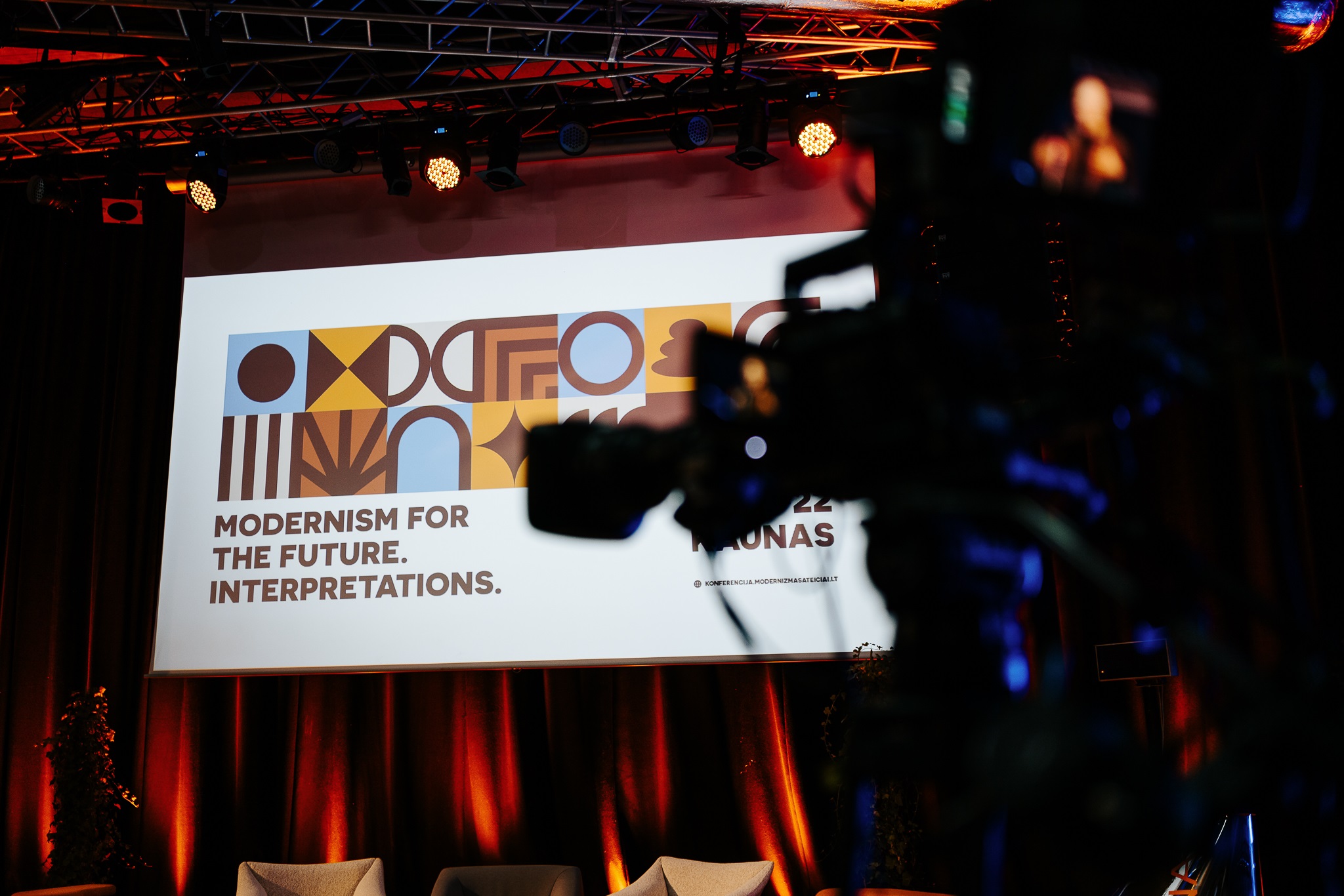
Tebby Ramasike, who will perform at the Ninth Fort: “In ugliness there is beauty and in darkness there is light”
2022-09-19Aktualijos,Current Issues,Interviu,Aktualijos,Pranešimai spaudai
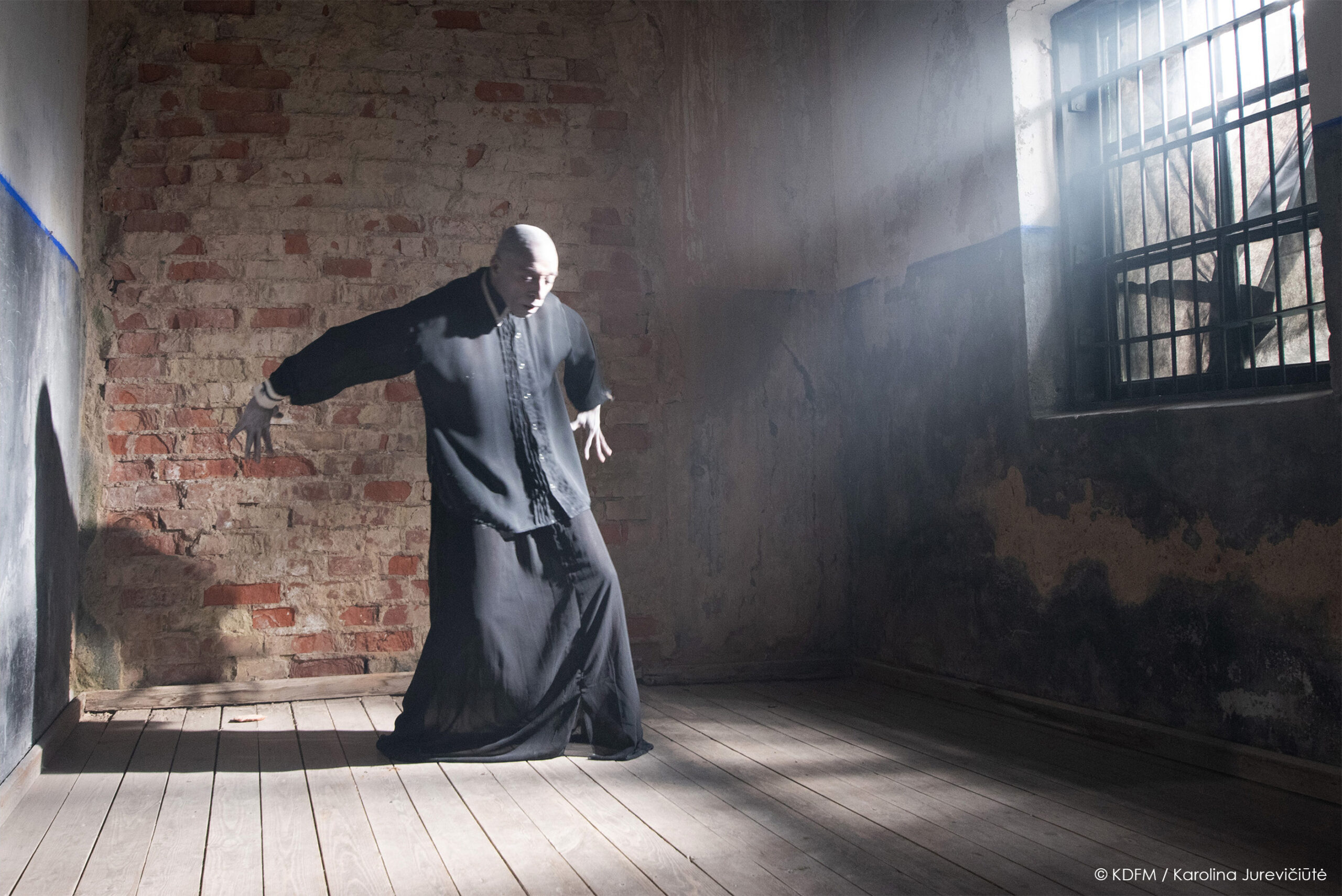
South African-born dancer and choreographer Tebby W. T. Ramasike has three decades of experience working on a professional stage. Ramasike doesn’t avoid drawing resources from painful historical events, which he combines with his personal experience and expresses in body language. On 24th of September, 2022, he will perform the performance “The Wreckage Of My Flesh” at Kaunas Ninth Fort Museum. In order to learn more about the performance, the dance in the context of traumatic experience, and the importance of remembering historical events, we invite you to read the interview with Tebby Ramasike.
The performance “The Wreckage Of My Flesh” is a part of the international project “ECCE HOMO: Those Who Stayed”, which is organised by Kaunas Ninth Fort Museum and Kaunas European Capital of Culture 2022.
On 24th of September, you will perform "The Wreckage Of My Flesh" at the Ninth Fort. First of all, I would like to ask you what impression and emotions did you have after visiting the Ninth Fort for the first time in 2021, during the preparation for the project?
That was quite an overwhelming experience. I saw pictures before that Bruce [visual artist Bruce Clarke] had shared with me, so I expected a different place. But when we were there, I just felt – Wow! At first, I didn’t know how to express it. I was so overwhelmed… I felt there was so much pain… There was a voice inside of me that was screaming out of pain, there was a voice screaming out of hope. It actually exceeded my expectations. I felt I was standing on a sacred ground. There was this intense and unique energy. It was not the structure of this place that actually caught my attention, but the surroundings, the environment, the trees around there... The trees became a representation of this symbolic nation of people that lost their lives there. There was the spirit that was living.
What was very interesting for me, is that I was not walking into a museum. I was not walking into an exhibition space. I was drawn into the living soul of humanity. Humanity that has been lost. I just connected with something there and creative ideas just flew immediately into my head. And I said, “I think I came to the right place. This is where I belong, this is what I wanna do.” My soul, my heart was pumping, and my spirit just wanted to live, wanted to grab, wanted to fly. It was so enriching for me.
Could you please shortly present your performance, which you will perform at the Ninth Fort?
I will go back to how the project started. In 2018, I was performing in a Butoh and Acousmatic Music festival in Paris. I happened to perform to Jacob’s composition. There was another Butoh dancer Denis, who was the original collaborator with me, but he unfortunately became very ill. He was performing to René’s composition. I was challenged by Jacob’s composition, which was short, complex and something that I’ve never dreamt of performing to. It was difficult, but during the performance everything just came together. I liked Denis’ performance and the composition by René. Then I said to the three of them that my idea is the four of us to be in the same space, we as dancers creating the dance, and you as composers composing at the same time. I proposed to them to collaborate, it was a small project for Amsterdam.
Then I started to develop ideas about the Holocaust and Apartheid. At the same time, I was writing a poem, and the title was “The Wreckage Of My Flesh.” This poem was inspired by seeing images of the Holocaust. I just put everything – the Holocaust images and the Apartheid images – together. At that time, I got very ill. I was hospitalised, I had 3 surgeries. I was in a hospital and all these images were coming back to me, and I felt like I was a part of that. My body was just disintegrating. I felt that my flesh was becoming wrecked, so I just said, “The Wreckage Of My Flesh.”
Next thing was – what do I do with this? What was the main focus in this project? Is it about the Holocaust? Is it about Apartheid? Or is it about me hospitalised and dying in my hospital bed? Being a Butoh practitioner, I’m always working a lot with the body. And I say – it was about the body.
When I saw my parents in South Africa after a long time, their bodies were deformed, changed. Then I started to think about the people in the extermination camp. When their bodies were put in these ovens, what happened? I started to think about people who were banned in South Africa. My very best friend from growing up – I saw him being tortured and burned, I saw his body… So, this was about the disintegrating body that is changing, that is being deformed.
Having experienced being in that hospital and fighting, affected me psychologically. It was a struggle. At the same time, I had to perform a piece. It was about dealing with the resistance to oppression, the resistance to the struggle. It was also about hope, about the fight against something, about resilience.
Thinking about these bodies as they were in the ovens or burning, I thought of the voice of their silent screams. I had this image of the body screaming. The body becoming the voice and screaming out. That voice became my inner self territory. For me, dance became my saviour, my healing notion. These voices in my head became like – “keep on dancing, keep on dancing and never stop to dance.” I had to dance to survive. I keep saying until today, if I didn’t dance, I probably would have kissed this life goodbye a long time ago. Dance has helped me to keep on going. Also, through dance, it helped me to resist. And never just stop and have that hope.
People ask if this piece itself is about the Holocaust. It’s not. And it’s not about Apartheid. Even though I’m drawing resources from this human history of horrific events that happened in the past (unfortunately, they are still happening now), it’s also about the social crisis that we, as human beings, are finding ourselves in. It’s a silent way of saying something with the body, bringing out that pain, bringing out that suffering, addressing something that many would not actually address, through dance being the voice of the people who have been silenced.
I decided in this piece to use the genre of Butoh, which carries the body’s resistance to gravity. For me, it’s a strong way of taking the body out of the comfort zone into an unknown territory. At the same time, it’s something about an inner freedom, which is experienced through Butoh or through the ritualistic dancing and even through electronic music, which also has its own way of resistance.
You have mentioned the Butoh genre. What thoughts and feelings do you have during the performance of Butoh dance? How does Butoh stand out from other genres?
It’s a transcendence into another world. I work a lot with spirituality, and I try to connect this with ritual dance and with my Butoh practice. For me, it’s always like a spiritual journey. I always have a feeling that I’m transcending from one life to the other. I’m transcending from the existence into the non-existence.
Butoh gives me this feeling of going into a deep subconscious world. I’m on a plain of that higher level of spirituality or maybe existence. But at the same time, I always have questions at the back of my head. Where are you going with this? Every question that I have raises a different feeling, a different thought. So, it’s never the same.
It’s still a growing thing inside of me. I cannot say I’m an excellent Butoh dancer or I’m a bad Butoh dancer. I’m a Butoh practitioner, I just practise. I developed my own concept of Afro-Butoh. I could say Butoh has actually enriched my dance career. I’m looking at dance and myself as a dancer from a different perspective, understanding my body, my thoughts.
How does Butoh genre stand out from the other genres? Well, the first thing, people are afraid of it. [laughing] When we talk about Butoh, they say, “Oh, is that one about ugly bodies and death?” It’s the way people respond to Butoh. People don’t want to deal with something that has to do with pain, suffering and death. Especially with death and darkness. I always say to people, in that ugliness there’s beauty, in that darkness there’s light.
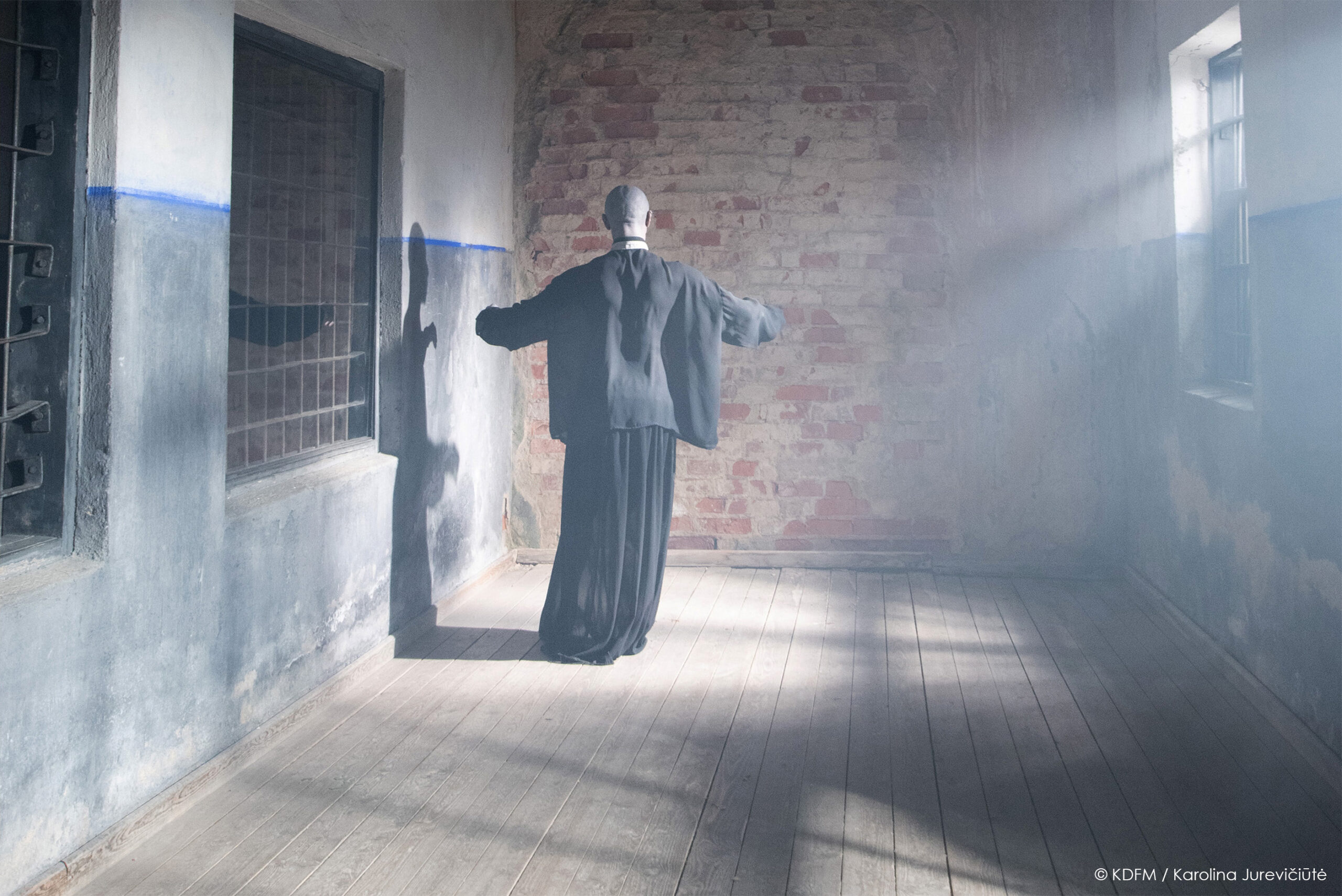
Let us pause for a moment to consider beauty, light, and dance – what, in your opinion, is the dance in the context of tragedy and traumatic experiences? A tool to empathize with other people's experiences? A way of healing?...
It’s not an easy question to answer, but I will try. If I look at it from the general point of view, it’s not that very easy, but for myself personally, it’s actually easy to work with dance and express traumatic or tragic experiences, because I dealt a lot with that. Even though people always say that I’m very happy, my world is actually tragic or traumatic.
I take a lot of people’s tragic and traumatic experiences into me, I listen to their stories. Sometimes I do make their stories my story. I basically put myself into their situation. When I start to do that, then sometimes I can create something out of that. Through dance it’s easier for me to express this. I also find that through dance it helps to heal myself. I could be caring so much and everything could be happening to me, but once I start to put this into dance, I feel this healing notion. As people have said to me, I’m bringing light into the darkness of their lives and I’m healing them. That’s why I’m always looking at my work from that spiritual healing notion.
One should not say, “Oh, my piece is gonna be about traumatic experiences.” I think if I start to say that, my dancers will rush out of the door. And I think if I tell the public that, they are not gonna come and see the performance. [laughing] It’s something that you keep into the work. A traumatic experience is not something that you put on the table just like that. It’s inside of somebody. Everybody deals with trauma in a different way. Every traumatic experience is on a different level as well.
In some of my dances, actually, I do express a lot of my traumatic experiences, which scares me at times. Then the problem becomes, what is the audience feeling when I go through a traumatic stage? Dealing with that through dance also helps me to release something, it heals me, it cleanses me. It’s like a ritual for me. It becomes like a ceremonial journey. Dance for me, and I think for many people, is healing, therapeutic. It’s a shame that many people don’t see it that way. They only see it as a hobby, as just dancing. They don’t realise that when you dance, there is something inside of a person that is happening. Dance brings joy, life, light, dance heals many people.
Let us go back to your performance at the Ninth Fort. An international team is contributing to it. Could you please introduce your team members?
I’m just gonna make a short introduction about them. I will start with René. René Baptist Huysmans is from Amsterdam. He is a composer and sound artist. He specialises in collages of electronic sounds and field recordings.
Jacob Elkin is from New York in the USA. He is a multi-instrumentalist. He is teaching at the United Nations International School and he is a specialist in electronic microtonal music. Don’t ask me what that is… This is why his music is very complex. All these terms… It’s not the same electronic music that we know. [laughing]
Denis Sanglard was the original member of the team, but because of health problems, he couldn’t continue with the project. He’s a Butoh dancer and an actor. He’s still very much involved in the piece, but more like on the sideline, as a coach or just giving feedback.
And then we have Ellen Knops, who is from Amsterdam. She is our lighting designer, and she loves to improvise and play around with the location. She’s the person who goes to a location and sees what the energy of the location is and what it gives her to do with the lights. She worked on many of my productions. She’s a fantastic person to work with.
Then we have Anne Oomen. She’s from Noord-Brabant. She’s a Dutch fashion textile designer. She specialises in silk. She works a lot with dancers, with movement. She was also a dancer herself as well. She translates a fascination for dance into the smooth movement of silk. Her work is very interesting to see on the body of the dancer. That’s also why I chose her. For many years we wanted to work together, this is finally the first project. She gets her inspiration from abstract painters and modern artists.
And then we have Elizabeth Damour. She’s from Paris. She’s a French Butoh performer, psychotherapist. She enjoys sharing, transmitting and connecting with the continuous development process. She works with young people as well. Elizabeth actually first joined the project as my assistant, not as the dancer. Then eventually, when Denis couldn’t continue, the only solution was Elizabeth.
Now we have Zo Fan. She’s an external artist in the project. She’s actually Bruce’s assistant. She was suggested by Bruce to be our videographer. She’s from Singapore, but she lives in Paris. She’s a film director, photographer and videographer.
Many people contributed to the project as well. It’s not only us; there are other people who are involved from the outside.
Your performance will be closely related to the exhibition by the artist Bruce Clarke exhibited at Kaunas Ninth Fort Museum – the dance will be performed in its background. What is the relation between the exhibition and the performance? How do they complement each other?
It’s interesting, because I didn’t know Bruce in the beginning. Frank [Frank Schroeder, the director of the National Museum of Resistance and Human Rights] knew my work and he knew Bruce, so he had invited Bruce to do the exhibition [in Luxembourg]. But I think when he saw Bruce’s work, then he saw me. The first time I saw Bruce’s sculptures, it was like: “Where did you find me?” [laughing] I also saw myself. I think it became like an instant connection.
What actually attracted me to Bruce was his background, which was like born in the UK, having a Jewish family, and [relations] with Lithuania, and the family in the Holocaust, and living in South Africa, being part of the Apartheid struggle. Then I saw his works and I was totally seduced. I wanted to know more about his works and I started to have ideas. What also grabbed me was his work in Rwanda with the genocide. I was just thinking, “These all are traumatic. These tragic situations that brought up a lot of trauma in people’s lives.” And I liked this because this was Tebby. [laughing] So, I thought, “I’m not going to have fear of actually trying to relate to his work. I’m just going to be an open book.”
In the past, I used to have artists that I would dance what they have painted or their sculptures. But now it’s different. We try to tell our stories in a different way and yet complement each other. What we also decided to devise, is this inter-dialogue between me and these sculptures, how I use them, because they have to be another performer.
This is something very interesting about the Ninth Fort Museum, it’s something that actually came to my mind: if we have these sculptures of Bruce and I’m relating to this installation and leaving the space, what happens? My idea is that you build up this relationship with these sculptures and you leave, and that relationship should still stay there even if my physical body is not there. It should stay within those sculptures because they’ve been part of the performance. It’s something that is possible because I always have this thing that an energy, that has been established, even when you leave the space should stay. I mean, when I went to the Ninth Fort Museum, even when I left, I could still breathe that energy.
What happens to me? This is another thing, the relationship between the installation and the dance. What happens to me as I dance with those sculptures, as I connect to those sculptures? What happens to me afterwards when I leave as a dancer? Do you just leave and then forget about them? No. I could choose to do that, but I don’t want to do that, because they are alive. It’s a major piece of artwork, so very important. I really have found something powerful in Bruce’s work that can actually enrich the dance.

Finally, the last question – why, in your opinion, it is important and necessary for today's person to remember traumatic experiences such as the Holocaust?
What happened in the past and what happened during the Holocaust is building our future. It’s part of our history. Whether you are Jewish, whether you are African, whether you are European... It’s part of us, it’s not only part of the Jewish community. It’s part of the world we live in. And, unfortunately, what happened during the Holocaust is actually coming back – it’s happening now. Even on a different scale, even in a different way… But I see it growing. I see it coming back in France: the nationalists are coming back. Then there’s Putin. He wants to be the master race, like Russia has to be the master race again as Hitler wanted Nazi Germany to be the master race.
Of course, people don’t want to deal with trauma, they want to distance themselves from the Holocaust. It was not a tragic story, it was really traumatic, something that kills the spirit of humanity. To be able to keep that as a memory is to believe, to understand it and to put it in that place of importance. It’s not just an event that happened and you leave it behind. It’s an important event in our historical lives as human beings. And it's really necessary for the generation now, our generation in the past, the generation in the future, to understand it, to remember it, to know that it happened. Because it will happen. We have already been saying that history repeats itself.
I just hope that the world will open up, believe, and finally say, “We understand,” and stop being in denial. The Holocaust did happen, traumatic experiences that people have gone through have happened and we cannot deny that. It’s a shame, because that denial is actually bringing up a lot of violence, which is scary.
The interview was prepared by Henrika Kryževičienė
The performance “The Wreckage Of My Flesh” by Tebby W. T. Ramasike will be performed at Kaunas Ninth Fort Museum on 24th of September, 2022. More information about the event can be found at Kaunas Ninth Fort Museum website: www.9fortomuziejus.lt/?lang=en
The project is a part of Kaunas European Capital of Culture 2022 programme.
The project is implemented by Kaunas Ninth Fort Museum and Kaunas 2022
Information partners: LRT, “Kauno diena”, KB “Katos grupė” | ACM
Partners: National Museum of Resistance and Human Rights (Luxembourg), Esch 2022
Kaunas School of Arts celebrates its centenary: invites to an exhibition and international conference
2022-09-14Current Issues,News,media-news
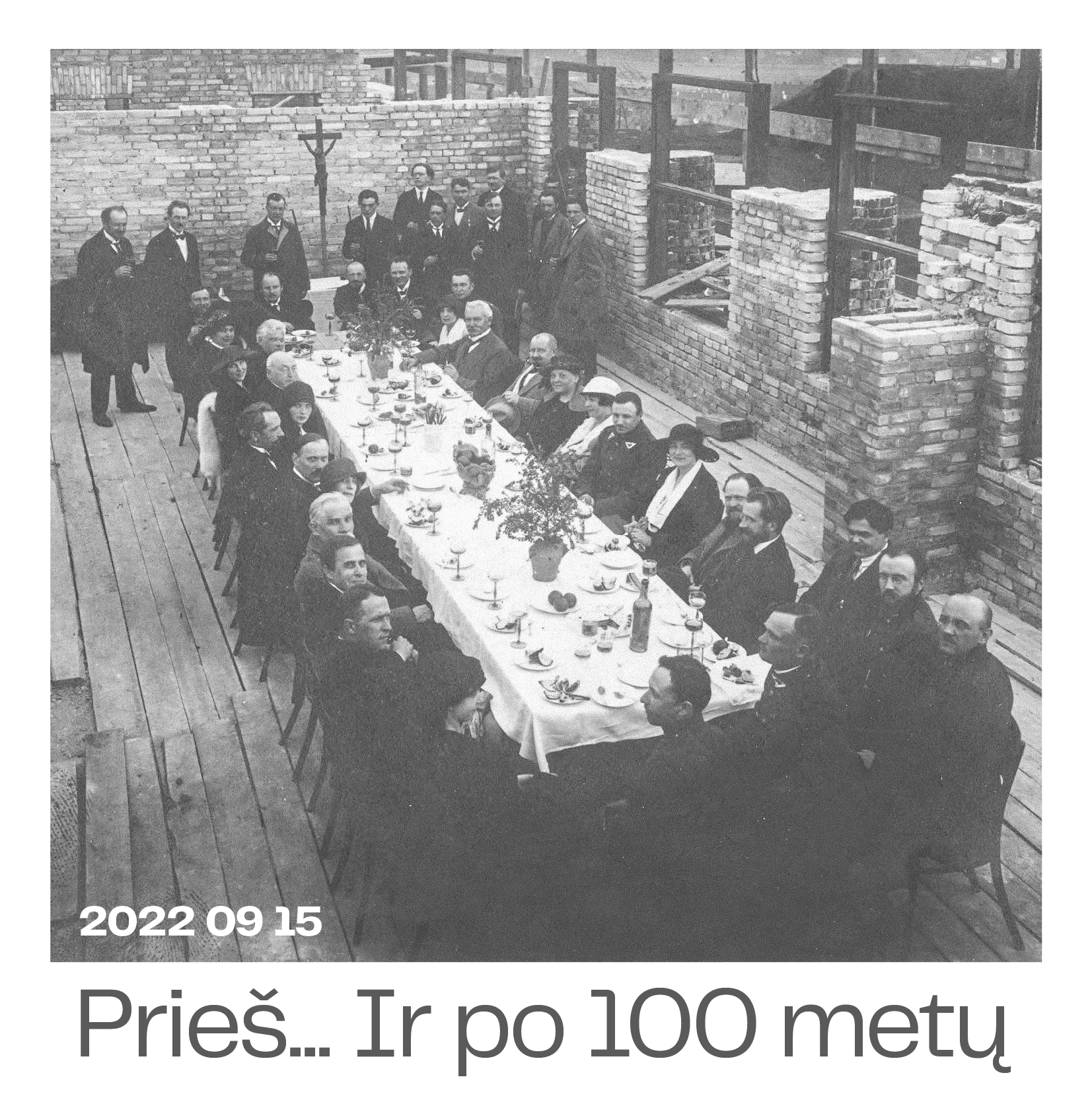
Kaunas School of Arts celebrates its 100th anniversary in 2022. To mark it, the international scientific conference “Art for a Modern Country in a Modern City” and the supporting exhibition “Before ... and after 100 years” will also be part of the events of Kaunas European Capital of Culture 2022.
The occasion marks the importance of higher studies in fine arts for modern art culture and the impact on the subsequent development and transformation of that culture.
The international scientific conference, dedicated to the anniversary, invites the participants to explore the significance of art studies for modernity; highlight their links with the processes of formation of modern states and cities, and discuss the historical, current and future state of education in fine arts and its relevant issues. It is expected to reflect on the history of the Kaunas School of Arts, its origins and evolution in the context of the city’s historical, political or economic changes and reveal parallels with other European art schools of the first half of the 20th century and the modernist movement in a new way. The conference also aims to highlight the activities of the personalities who founded the School and studied here – artists, pedagogues, architects, and art historians – and the links between their creative work and the local, national and global context of fine arts and reveal the origins and continuity of the traditions of the Kaunas School of Arts.
Conference dates: 15 September, 9 a.m. – 5 p.m. and 16 September, 9:30 a.m.- 4 p.m.
Venue: the National M. K. Čiurlionis Art Museum, Music Hall (V. Putvinskio Str. 55, Kaunas).
Conference speakers: Prof. Dr habil. Antanas Andrijauskas (LT), Prof. Dr Stanislavas Mostauskis (LT), associate prof. Dr Ramutė Rachlevičiūtė (LT), associate prof. Dr Aušrinė Cemnolonskė (LT), Dr Stella Pelše (LV), Margus Meinart (EE), Dr Theodor Liho (BG), Yaroslav Kravchenko (UA), Lina Mumgaudytė (LT), associate prof. Dr Aušra Vasiliauskienė (LT), Rūta Marija Purvinaitė (LT), associate prof. Dr Inese Sirica (LV), Šelda Puķīte (EE), Dr Lijana Natalevičienė (LT), Prof. Dr Raimonda Simanaitienė (LT), Dr Aistė Dičkalnytė (LT), Daina Zozaitė (LT), associate prof. Dr Odeta Žukauskienė (LT), Dr Vilma Gradinskaitė (LT), Vaida Sirvydaitė (LT), Lina Hall (LT), Ilona Mažeikienė (LT), associate prof. Dr Rasa Butvilaitė (LT), associate prof. Dr Lina Preišegalavičienė (LT), associate prof. Dr Vaida Almonaitytė-Navickienė (LT).
More information about the events is available here.
September in Kaunas – world renowned names, premieres and exhibition openings: what not to miss?
2022-09-08Current Issues,News,media-news

Autumn’s first month is once again inviting us to return to cinema, theatre, and concert halls. September also brings a host of European Capital of Culture premieres, from the launch of the modernist film Folds (Klostės) to the long-awaited Kaunas Cantata and the opening of Yoko Ono’s exhibition. Kaunas 2022 is pleased to share their recommendations on what to see and what not miss in the autumnal city.
Yoko Ono’s retrospective exhibition The Learning Garden of Freedom
The Learning Garden of Freedom is a retrospective exhibition of Yoko Ono’s work organized in collaboration with Studio One in New York, founded by the artist herself, the Contemporary Art Centre in Vilnius, and Kaunas Picture Gallery in Kaunas. The exhibition presents an overview of Yoko Ono’s works, including various creative periods and practices ranging from conceptual art and experimental films to spatial installations, objects and performance art.
When: 10 September – 4 December
Where: Kaunas Picture Gallery, K. Donelaičio St. 16
See here for more information.
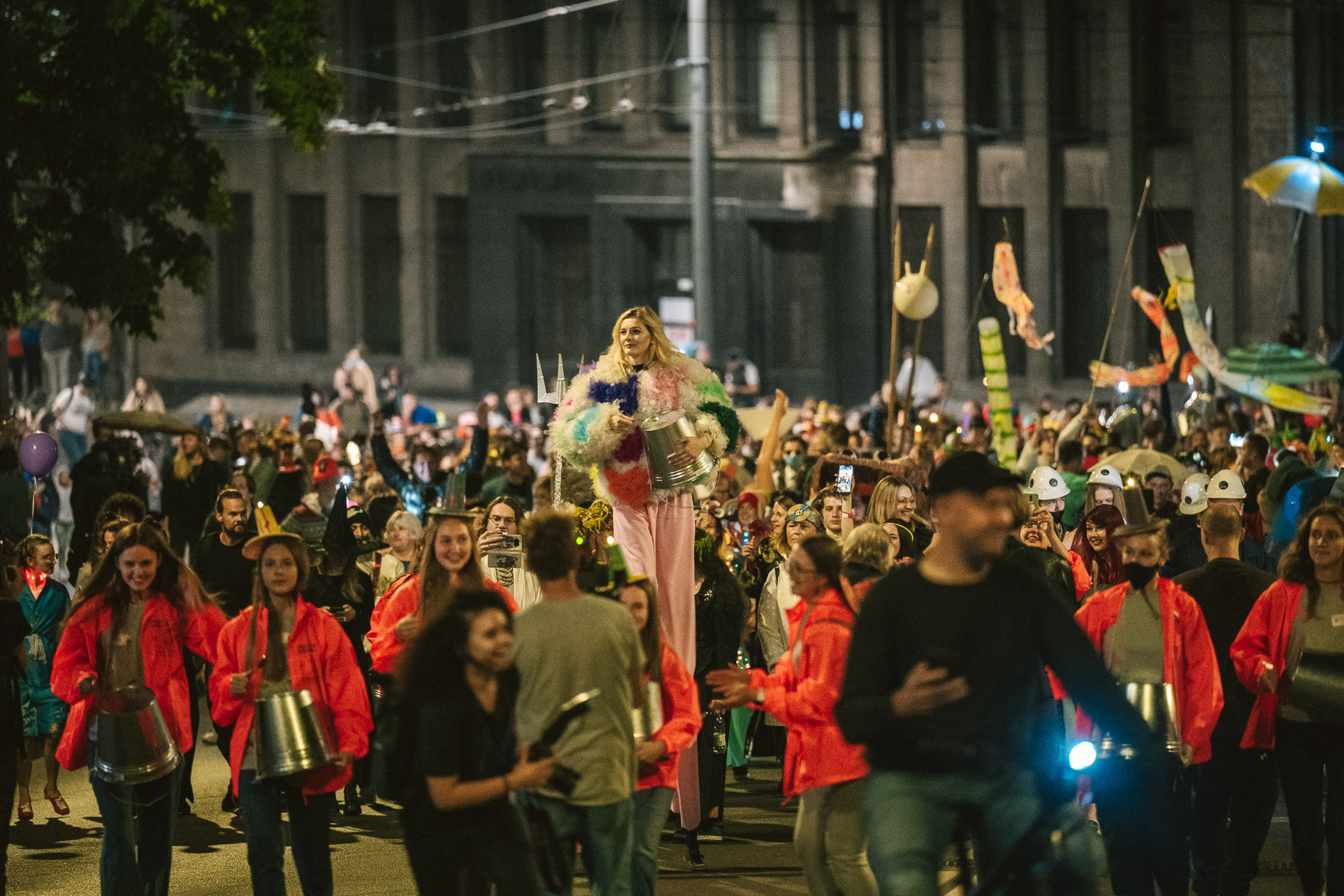
Fluxus Festival
On 10 September, Kaunas welcomes a return of the Fluxus Festival, organized by the Kaunas 2022 community programme Fluxus Labas. A festival that has become a tradition in the city will, this year, evolve into the biggest event of its kind ever. Expect the unexpected in original performances by Lithuanian and foreign artists who love to smile at life as well as the flamboyant climb up the Parodos Hill, the highlight of the festival.
When: Fluxus Climb – 10 September, 10 p.m.
Where: Parodos Hill
See here for more information
Litvak Culture Forum by Kaunas 2022
On 29–30 September, Kaunas 2022 will invite Litvaks scattered throughout the world to return, even if only briefly, to their ancestral land and gather at the Litvak Culture Forum for Kaunas residents and visitors. Over several days, this event will feature a rich cultural programme and discussions with renowned artists, researchers, and cultural figures, and is open to everyone interested in the city’s history. Guest speakers include: Prof. Antony Polonsky, Prof. Peter Salovey, Prof. Tsvia Walden, artists Michael Shubitz and Bruce Clarke, and many others. Patron of the Forum – Prime Minister of the Republic of Lithuania Ingrida Šimonytė. Honorary patron – Prof. Liudas Mažylis
When: 29–30 September
Where: Great Hall, Vytautas Magnus University, S. Daukanto St. 28
See here for the full programme.
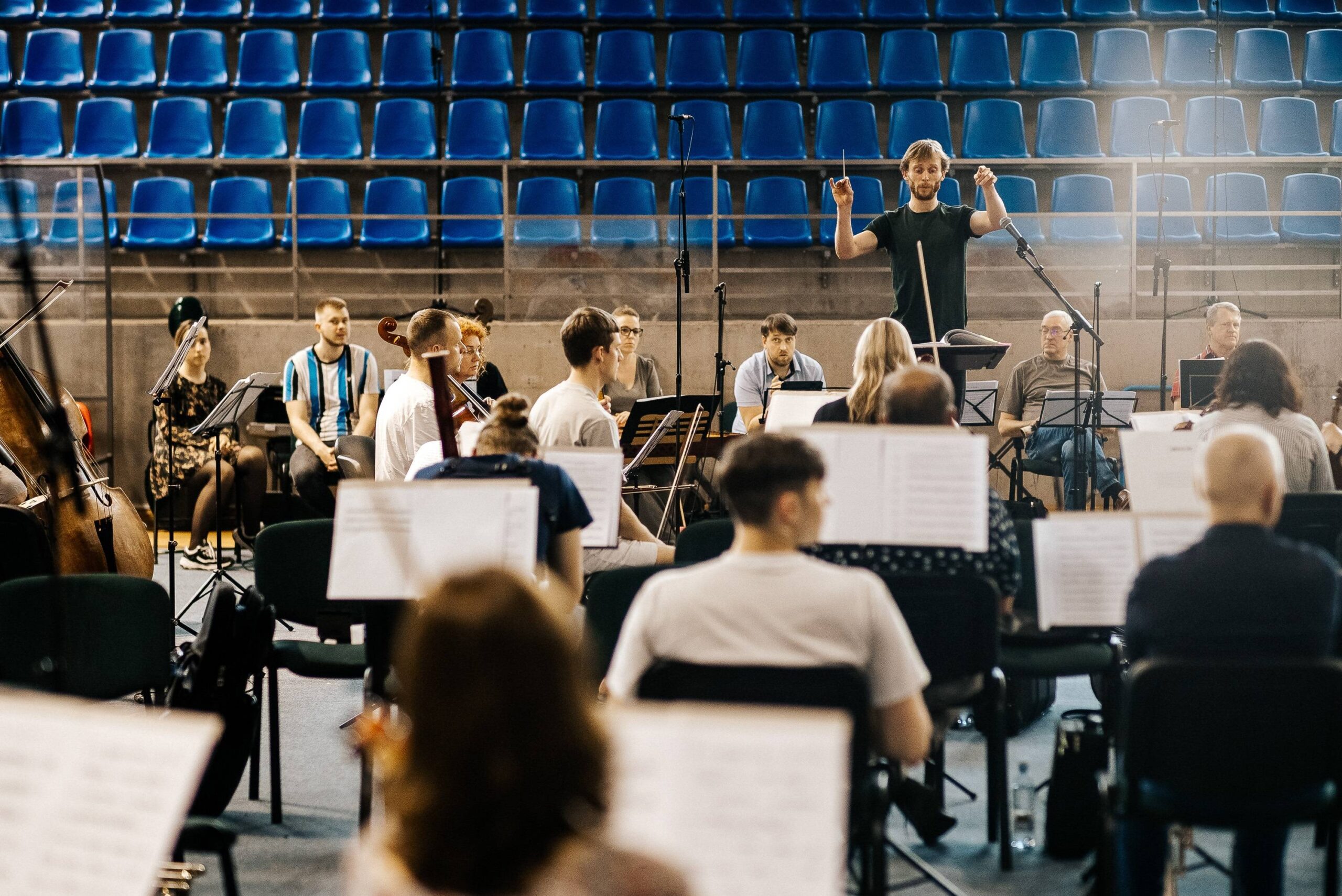
Kaunas Cantata
An extraordinary immersive musical experience, created especially for Kaunas and the people who love it. Composer Philip Miller and visual artist Jenny Kagan, together with Lithuanian music performers, will invite the audience to choose what to listen to and what to hear. The work was inspired by Kaunas residents’ personal testimonies, memories, as well as the rich and diverse world of sounds.
When: 30 September – 1 October 1, 7 p.m.
Where: Kaunas Žalgiris Arena
Book your tickets here.
Interactive exhibition Out of Darkness
Artist Jenny Kagan, daughter of Juozapas Kagan and Margarita Štromaitė from Kaunas, grew up in the United Kingdom, surrounded by stories of pre-war and wartime Lithuania. In the exhibition Out of Darkness, she brings the extraordinary story of her parents’ survival in Kaunas during the Holocaust to life. The exhibition’s setting, including images, music, video projections, and other elements, immerses the viewers in a narrative that is both personal and universal.
When: until 30 October
Where: Gimnazijos St. 4
Book your tickets here.
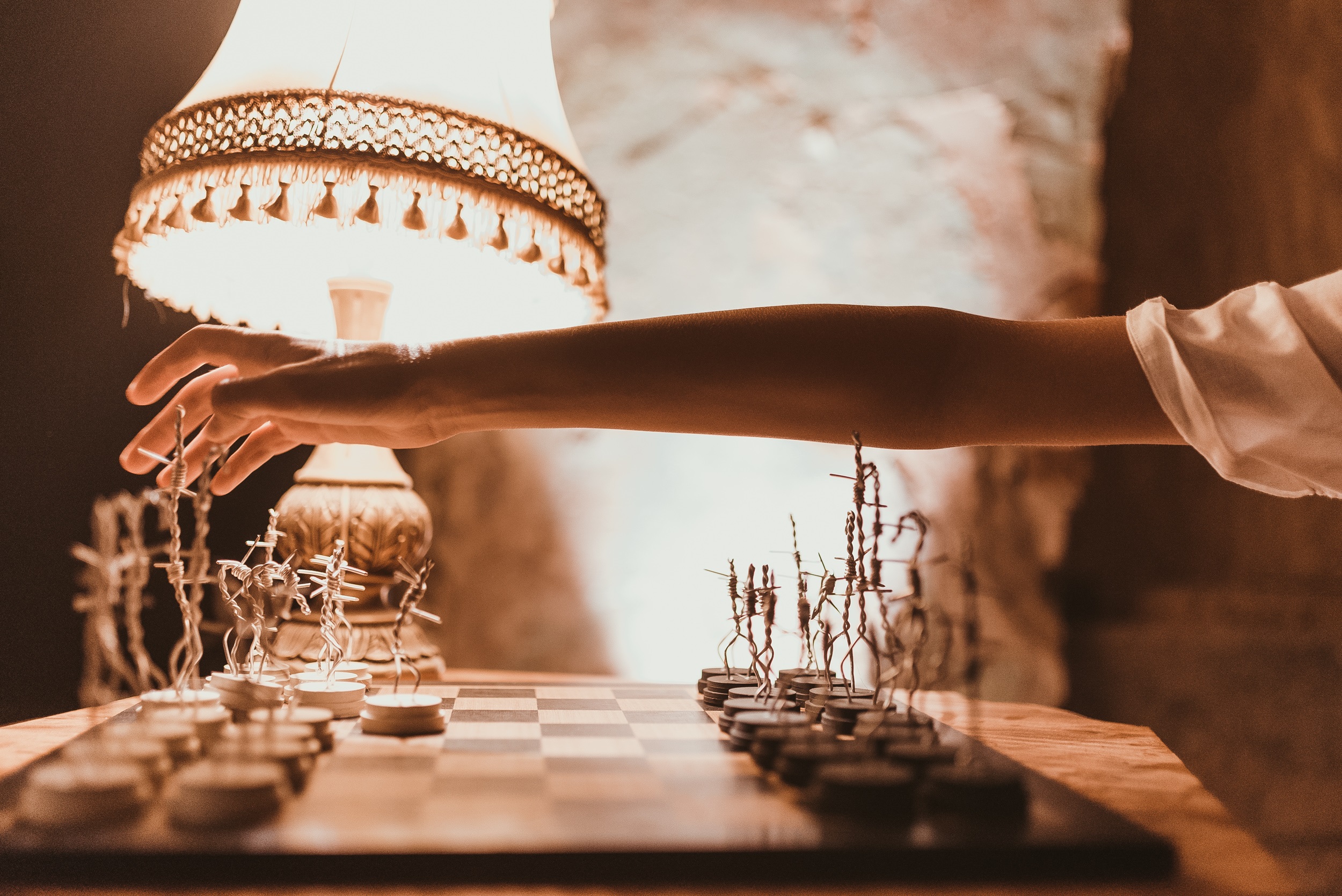
Conference Modernism for the Future. Interpretations
Modernism for the Future. Interpretations, a conference that has already become an annual tradition, will symbolically conclude the five-year programme. Curated by Vaidas Petrulis, the event is expected to foster debate and dialogue between a wide range of experts in different fields. Speakers from Lithuania and abroad will share best practices and insights on modernism as an inspiration for creativity and discuss cases of artistic communication of modernist architecture as well as their relevance in considering possible visions for the future of heritage.
When: 21–22 September
Where: Amphitheatre of Kaunas Žalgiris Arena and other locations
See here for the full programme.
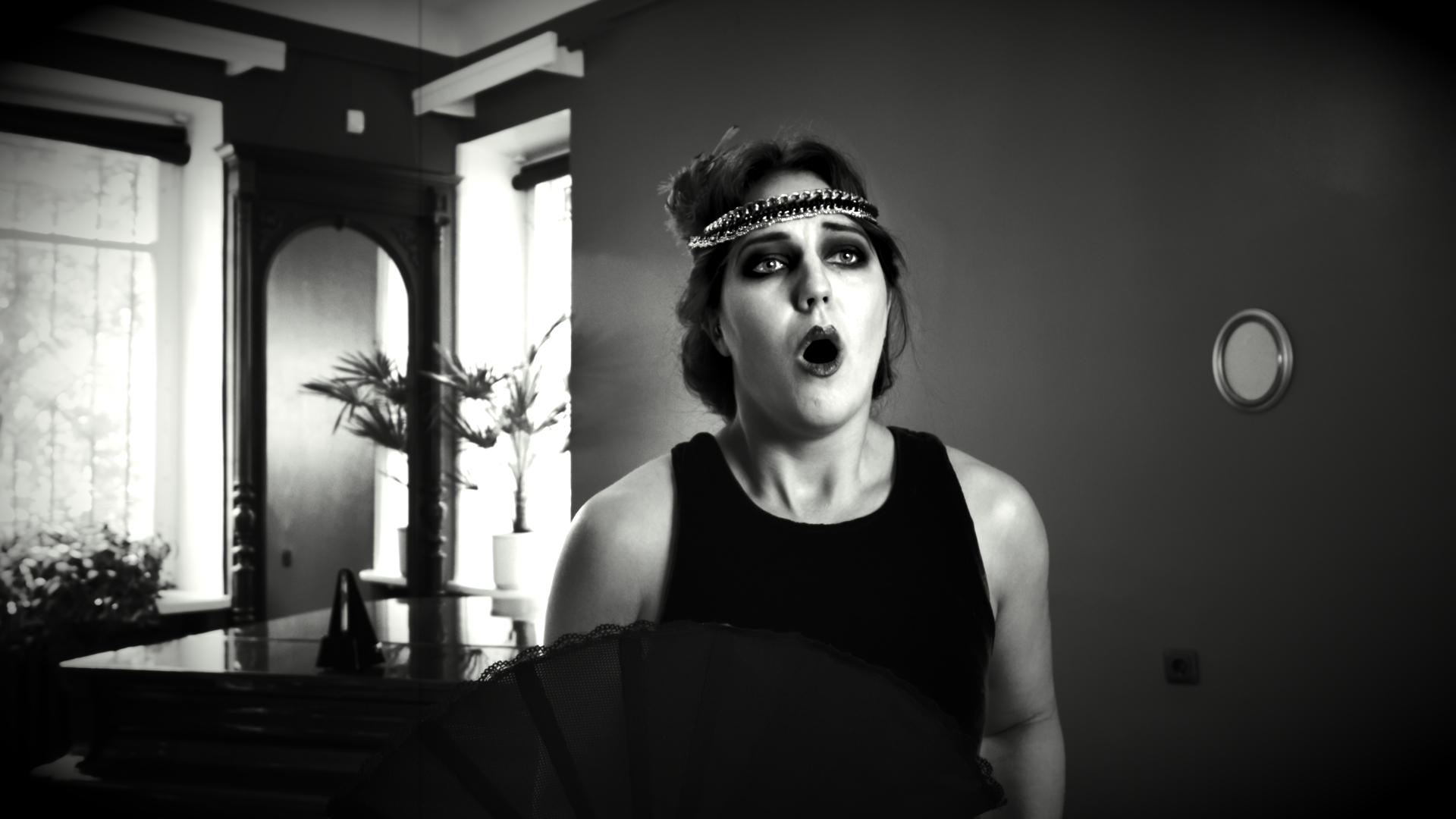
Premiere Klostės / Folds
Klostės / Folds is a 67-minute black and white silent film made by artist Aideen Barry and the residents of Kaunas. On 22–24 September, the film will be premiering in Kaunas at Romuva Cinema which will be opening its doors to visitors again after reconstruction. The film was inspired by Kaunas modernist architecture and the magical stories that lie within it. It was a unique two-year creative process that brought together over 600 local residents and professional artists.
When: 22–24 September
Where: Romuva Cinema
Cultural experiences in Kaunas district
In September, Kaunas district will once again become a centre of attraction. The project Contemporary Neighbourhoods will invite everyone to Rokai, Lapės, Linksmakalnis, and Kačerginė to join a number of colourful festivals organized by local communities. Cultural surprises also await in Zapyškis. The former dredger Nemuno7 will host the Agents exhibition, the fourth part of the Fluid Bodies exhibition series, and participating artists of the OSTRALE Biennial residency will present the results of their work in 3 marine containers situated on the banks of the Nemunas.
When, where: Rokai (03/09), Lapės (03/09), Linksmakalnis (10/09), Kačerginė (04/09), Agents exhibition (until 21/09), OSTRALE contemporary art exhibition (from 05/10)
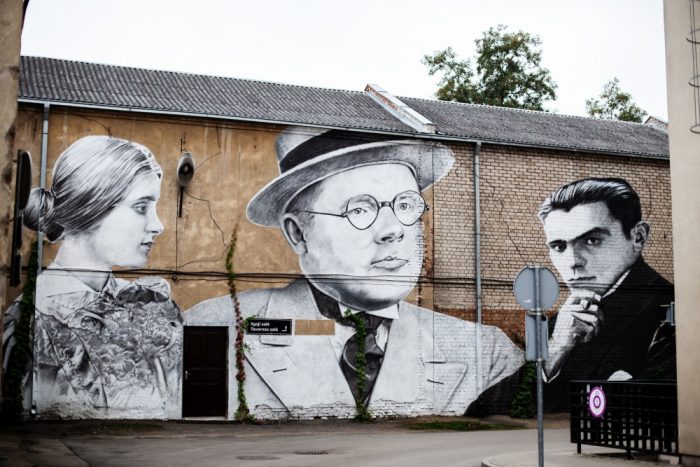
Magenta Landscape Design Festival
Which comes first – nature in the city or the city in nature? Magenta Landscape Design Festival will invite you to reflect on this question between 9–25 September. Residents of Kaunas and Kaunas district will have a chance to enjoy almost 20 new objects of design, tactical urbanism, and landscape design, and a rich festival programme.
When: 9–25 September
Where: Kaunas
Organizer: public institution Šeimos laikas
See here for more information.
Kaunas Architecture Festival East-East
The international project East-East for professionals and the general public is returning to the programme of the Kaunas Architecture Festival. It is the result of a long-term cooperation which has laid the foundations for a previously non-existent architectural exchange between Lithuania and Japan. The festival’s programme includes a forum, exhibitions, lectures by professionals, and a competition for architecture students.
When: 22 September – 22 October
Where: Kaunas Central Post Office, Žalgiris Arena amphitheatre
Visit www.kafe.lt and www.laskaunas.lt for more information.
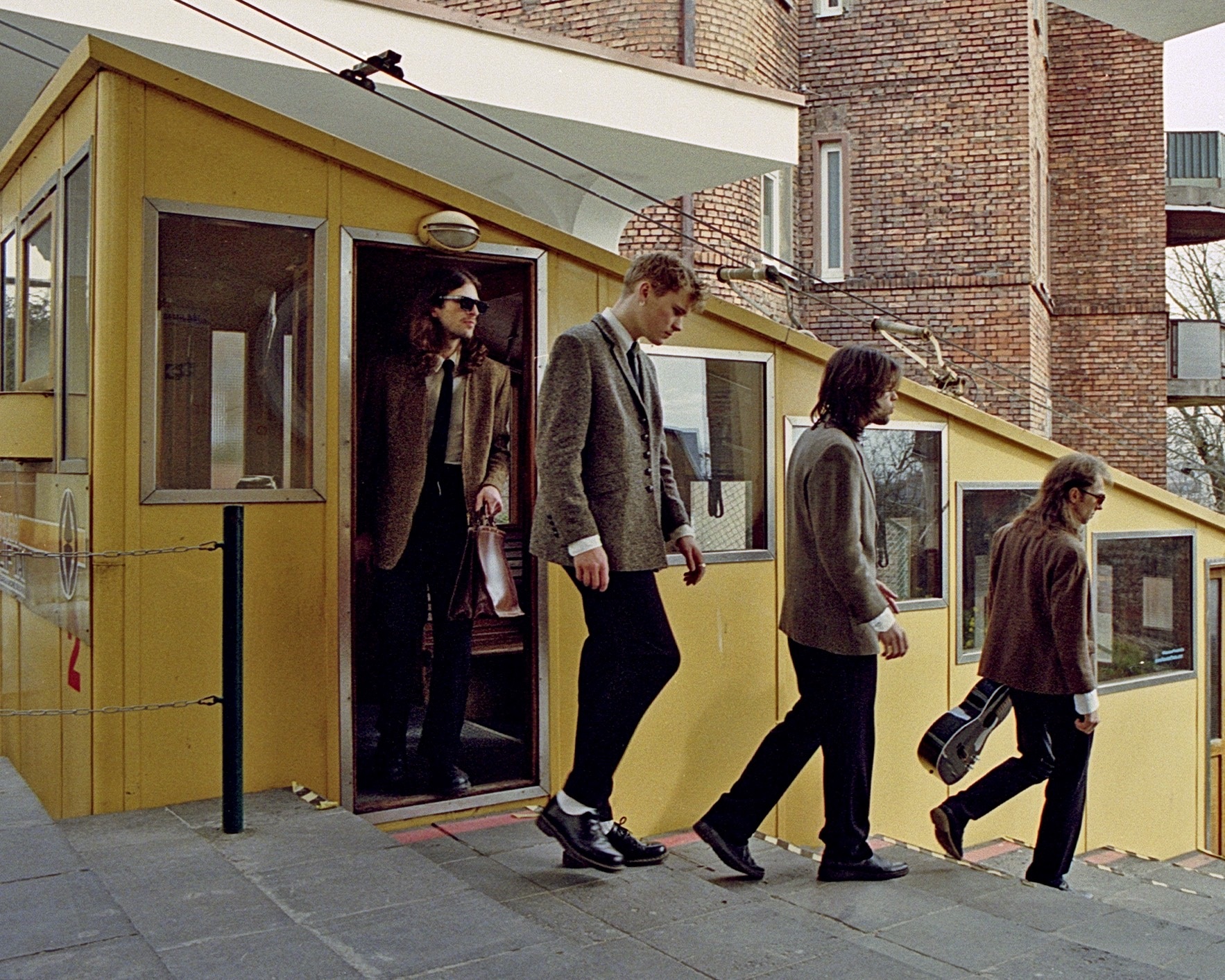
Kaunas 2022 Summer Stage
September marks the last month of Kaunas 2022 Summer Stage. The Town Hall Square has already hosted many representatives of the music, theatre, and even gaming scenes from Lithuania and abroad. This month, the Golden Parazyth, Gischt (AT), Rūta MUR, Tim Freitag (CH), ABUDU and many others will appear on stage.
When: until 17 September
Where: Kaunas Town Hall Square
See here for more information about free concerts and events.
Dorian by Robert Wilson
The play Dorian marks a historical event in the history of Kaunas National Drama Theatre and Kaunas culture. Robert Wilson, one of the world’s most renowned contemporary theatre directors and stage designers, in collaboration with Dhouse (Düsseldorf, DE), will tell the Kaunas audience the tale of a pleasure-seeking prince who cannot find himself in the time he lives in.
When: the play premieres on 1, 2 and 7 October.
Where: Laisvės Av. 71
Organizers: Kaunas National Drama theatre
Book your tickets here.
Summer is ending but culture continues
The much-loved project Culture in the Courtyards continues, this time visiting Aleksotas. The role of culture and artistic ideas in the debate on Europe’s future will be further reinforced by a session of the European Parliament of Culture. Yoko Ono’s installation Ex It will be entering its final days, and the CityTelling Festival will revive historical memory. The full Kaunas 2022 programme is available at www.kaunas2022.eu or on the mobile app.
The biggest Litvak Culture Forum in Lithuania will gather lovers of culture and history
2022-09-08Current Issues,News,media-news
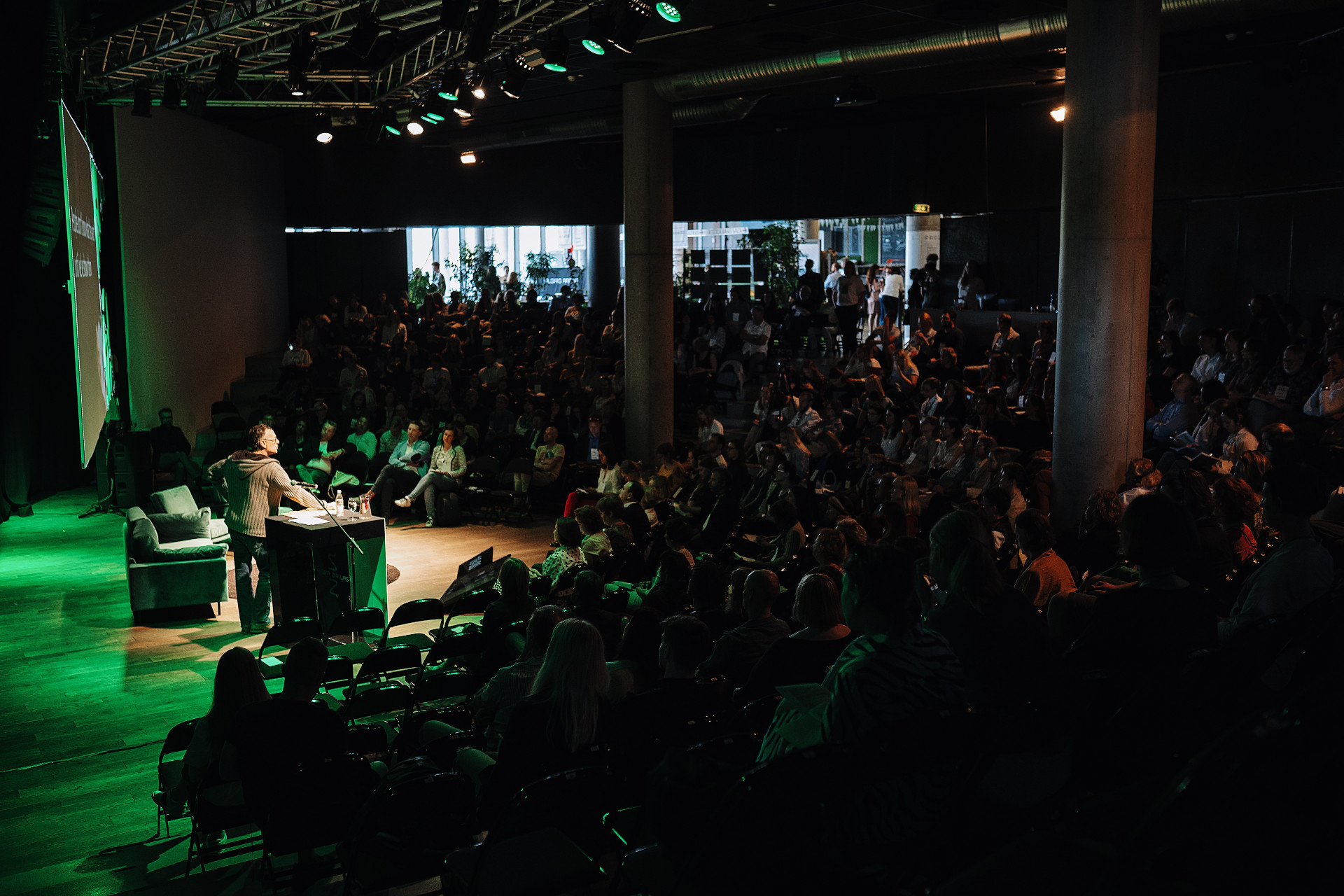
Culture enthusiasts are welcome in Kaunas on 29-30 September. The first Litvak Culture Forum will take place here. The Forum, initiated by the Kaunas 2022 programme “Memory Office”, will be followed by a varied programme of art events in different parts of the city.
Academics, historians, museum professionals, education experts, representatives of the art world, and community members - the Forum will bring together dozens of speakers from various fields and countries. Many of the guests will be visiting the land of their ancestors for the first time - these experiences are crucial in an event that raises the question of what it means to be a Litvak. Other themes of the Forum include culture and art as a key to history and the perpetuation of memory as a way to build a better future and promote openness and dialogue.
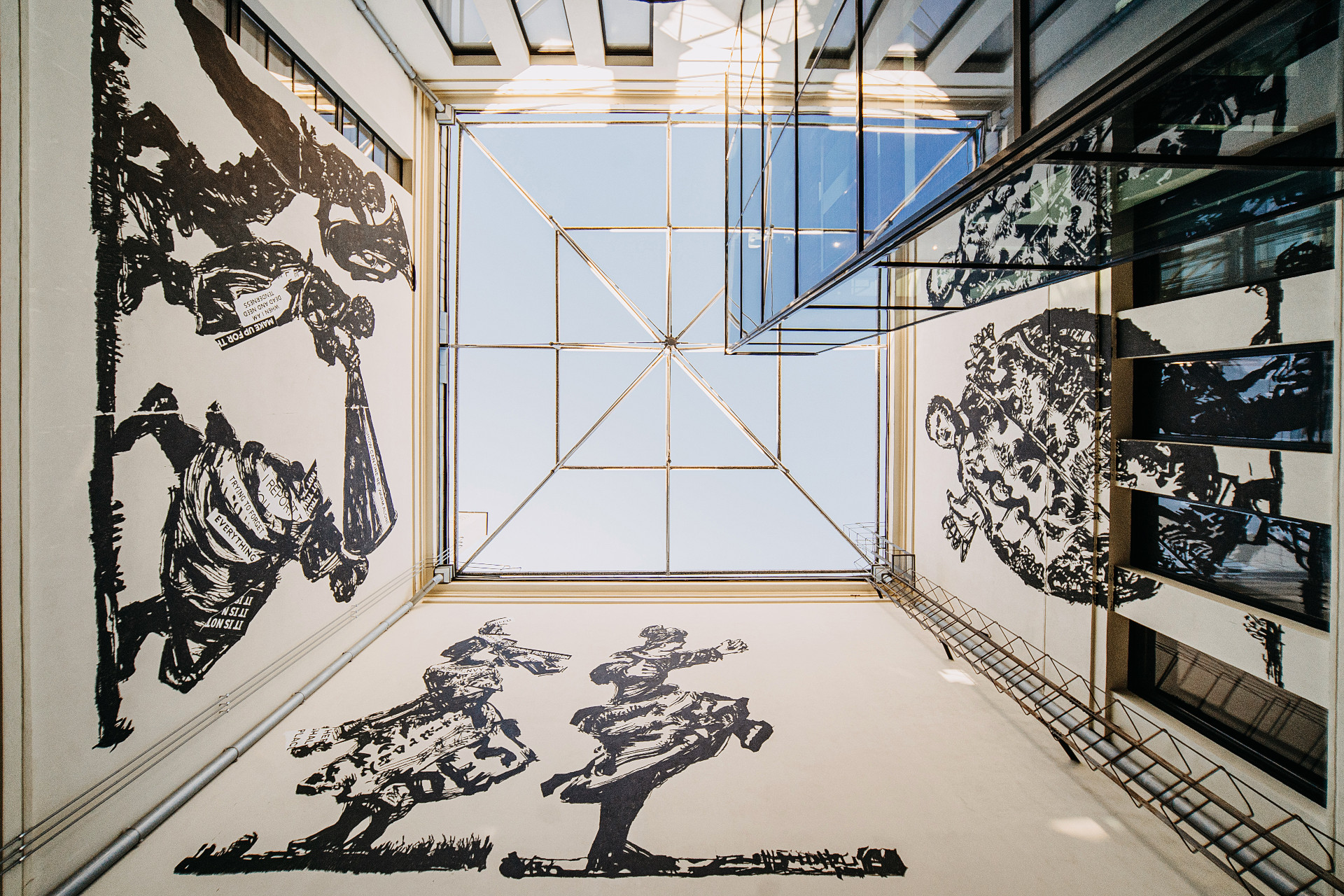
Returning to the Roots
According to Daiva Price, curator of the Kaunas 2022 “Memory Office” programme, the Litvak Culture Forum is a summary of the programme’s efforts and projects started in 2017. “For five years we have been trying to remind people that Kaunas has always been a multiethnic city and that the Jewish or Litvak part of its history is an important part of its identity. Through various art projects, we have talked about the complex pages of the city’s history, World War II and the tragedy of the Holocaust. So during the Forum, we will try to summarise what Litvak identity is and how art helps us to understand the history and remember,” intrigues the curator.
According to Ms Price, it is important that not only Lithuanian artists have been involved in this dialogue about the wounds of our history, but the project has also encouraged Litvak artists and scholars to return to the land of their ancestors. One of them is Prof. Peter Salovey, a descendant of the famous Soloveitchik family from Kaunas, a Litvak and President of Yale University: “The Forum is, therefore, a great opportunity to revisit our common past, to meet and reflect on the future, to discuss what kind of future we want for this city, and how (or if) art can help us to understand the history better and learn from its mistakes.”
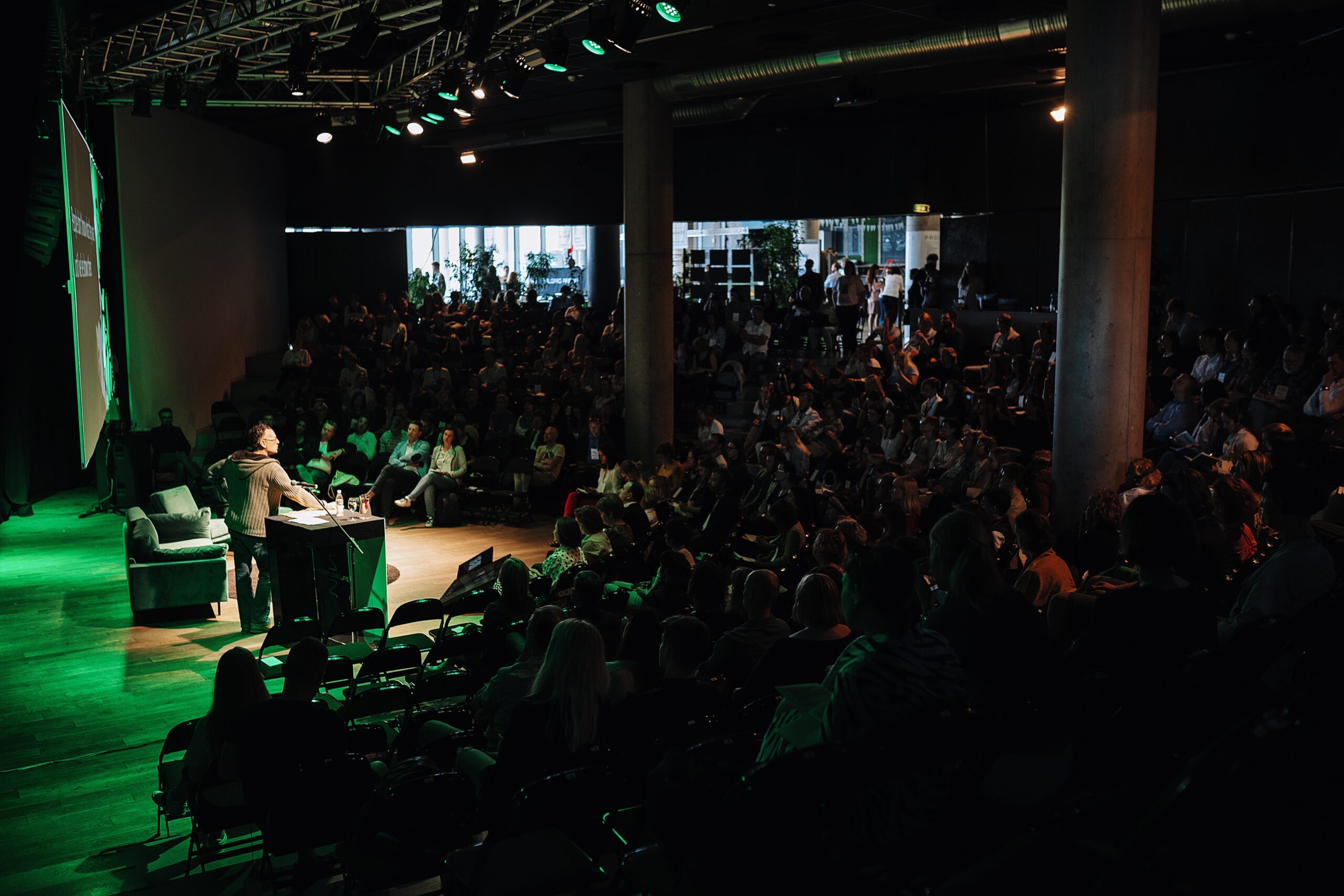
Artists and Academia
Lithuanian and international artists such as writer and art curator Paulina Pukytė, Lina Šlipavičiūtė-Černiauskienė (project “Walls That Remember”), Jyll Bradley (UK), who has brought back the mezuzahs to the streets of Kaunas, translator of Leah Goldberg’s book “A Flat for Rent” writer Daiva Čepauskaitė, artist Sigutė Chlebinskaitė, among many others.
Prof. Violeta Davoliūtė, a researcher of the politics of memory in East-Central Europe, will represent the academic community, as well as a large group of scholars from all over the world. Among them are Prof. Antony Polonsky, Professor Emeritus at Brandeis University, author of numerous monographs (PAR/UK), Prof. Peter Salovey, Professor of Social Psychology, President of Yale University, Honorary Doctor of the VMU (USA), Prof. Tsvia Walden, Psycholinguist (IL), and others.
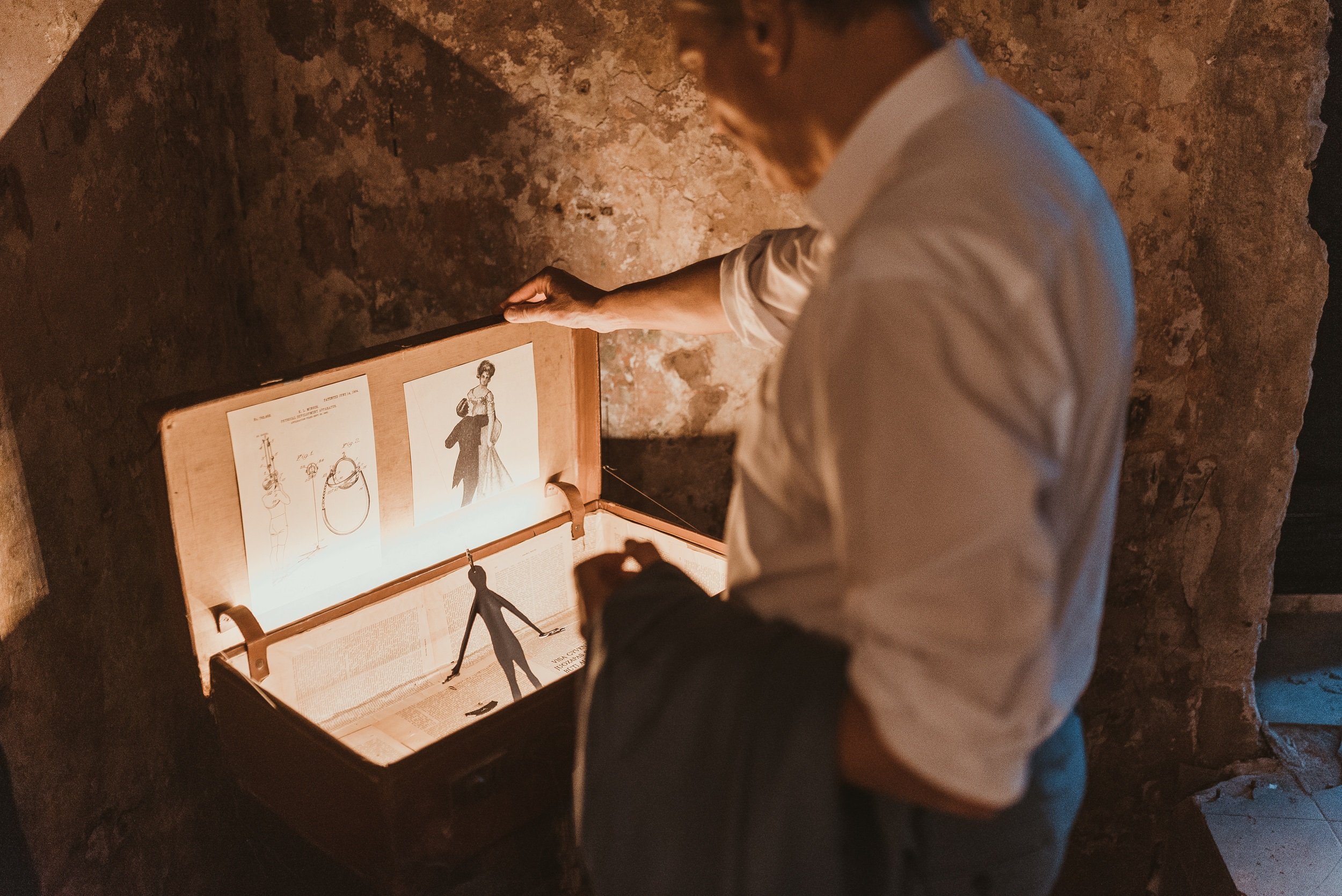
Rich Cultural Programme
During the days of the Forum, special musical projects will be presented to the participants and guests at Žalgirio Arena. On 29 September, a concert of Yiddish songs by Marija Krupoves, dedicated to the Jewish memory of the city and the special spirit of Kaunas is scheduled. On 30 September and 1 October, the focus will be on the premier of Kaunas Cantata by composer Philip Miller and artist Jenny Kagan. The Cantata tells the complex story of historical upheaval, the Holocaust, deportations and personal trauma, and the traces it has left in the lives of generations and individuals in the language of music, texts and images. The premiere will be performed by over 200 musicians, the Kaunas Symphony Orchestra, choirs and various ensembles.
During the Litvak Culture Forum, a number of unexpected artistic events will take place in Kaunas, helping to broaden the context of the discussions and to extend the conversations. n born in Israel, "Bringing back to Kaunas" will be presented in the central building of VMU. On 28 th of September the photography exhibition by Michael Shubitz, a Lithuanian born in Israel, "Bringing back to Kaunas" will be presented in the central building of VMU, while, the Emanuel Levinas Centre at LSMU will host a concert-narrative entitled “The Music Shell”, during which an international group of artists will perform original music inspired by Jewish folk songs, ceremonial music and professional music.
On the 29th of September, two musical events will be happening in the city: a performance by pianist Aleksandr Paley and clarinet master Karolis Kolakauskas and the concert "After Shagal“. The recently deceased composer Anatolijus Šenderovas said of this later work: “[It] is full of symbols - the clarinet recalls the former Jewish life in Europe, the percussion and the string quartet are like an allusion to the biblical world.” The work will be performed by the Chordos String Quartet, clarinettist Algirdas Žiūra and percussionist Arkadijus Gotesmanas.
The programme of events will also include exhibitions that are already in place and have been attracting a great deal of interest from the city’s inhabitants and visitors, such as William Kentridge’s “That Which we do not Remember” and Jenny Kagan’s “Out of Darkness”.
Participants will also be invited to visit Kaunas Fortress IX, where artists Bruce Clarke (FR) and Tebby W. T. Ramasike (NL) will present the visual art and contemporary dance work “Ecce Homo: Those who Stayed”.
The patron of the Lithuanian cultural forum is Prime Minister Ingrida Šimonytė. Patrons of honour - prof. Liudas Mažylis and Faina Kukliansky, chairman of the Lithuanian Jewish community. Partners - Vytautas Magnus University and the Lithuanian Jewish Community.
More information about the events is available here.
The first half of the European Capital of Culture ends: a record number of visitors and international media attention
2022-09-08Current Issues,News,media-news
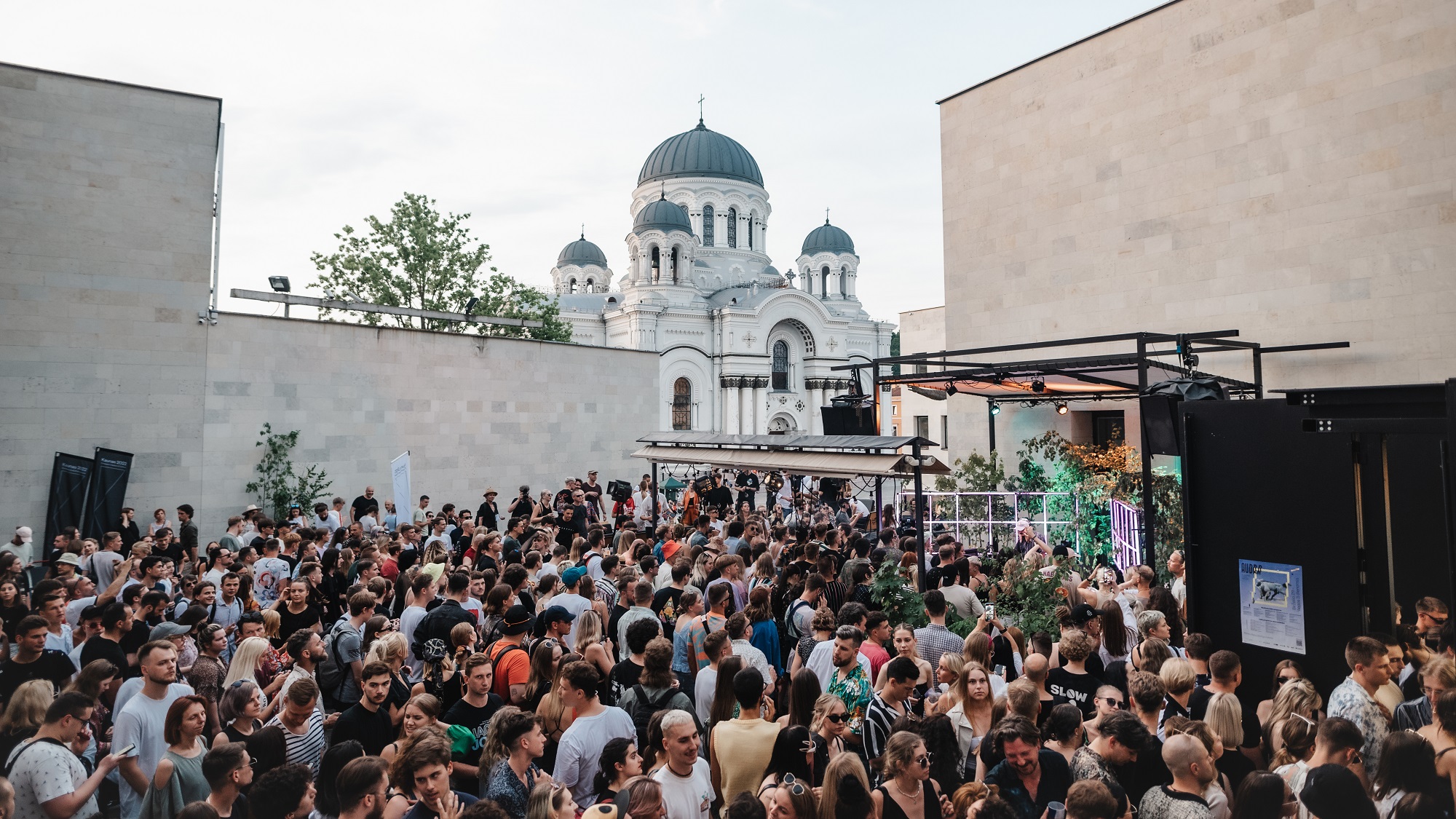
Kaunas is in the midst of the year as the European Capital of Culture, with over 1,000 planned events that will change the cultural face not only of the city but also of the whole country. From record-breaking numbers of visitors to increased media attention, the team of Kaunas 2022 reveals the results of the first half of the year.
“By August, more than 600 events – exhibitions, theatre plays, festivals and concerts – had already been organised in Kaunas and Kaunas district. We estimate that in the first half of the year, more than 800,000 people visited them and more than 6,000 professionals contributed to the programme. It is not just the numbers that are pleasing, but every day we also feel that people are engaged. From the very first day, we wanted it to be a community project that would involve in culture as many residents of the city, professionals, and the young generation as possible,” Virginija Vitkienė, Head of “Kaunas 2022”, says.

Record number of people at events
The most awaited and the most attended event of the “Kaunas 2022” programme was the visit of the Serbian performance artist Marina Abramović and the opening of her retrospective exhibition “Memory of Being”. The public lecture by Abramović was attended by 6,000 admirers of the artist and the exhibition was visited by over 25,000 visitors. Other exhibitions have been equally well attended, for example, more than 27,000 visitors attended the exhibition “That Which We Do Not Remember” by Kentridge, which runs until the end of the year.
The events of the Contemporary Trilogy of Kaunas Myth were also very popular. In January, over 150,000 people watched the cultural “Uprising” in Kaunas in front of the whole of Europe, and in May, “The Confluence” weekend attracted over 300,000 cultural enthusiasts.
“It is not only the involvement of Kaunas residents that is encouraging, but also the fact that the city is becoming increasingly more interesting to the international audience. By July, around 20,000 tourists had visited Kaunas. I think that the well-known names, the events of Capital of Culture have helped to reach the people in countries of Europe. Visitors from abroad are interested in Kaunas modernism, exhibitions, and the newly opened CulturEUkraine Centre for Ukrainian creators. We welcome many Germans, Italians and people from neighbouring countries – Poland, Latvia and Estonia. It is great to see that increasingly more people are coming to Kaunas not for half a day, but for a whole weekend or a few days – there are increasingly more activities to be found here,” Mindaugas Reinikis, Head of the Communication and Marketing Department, says.
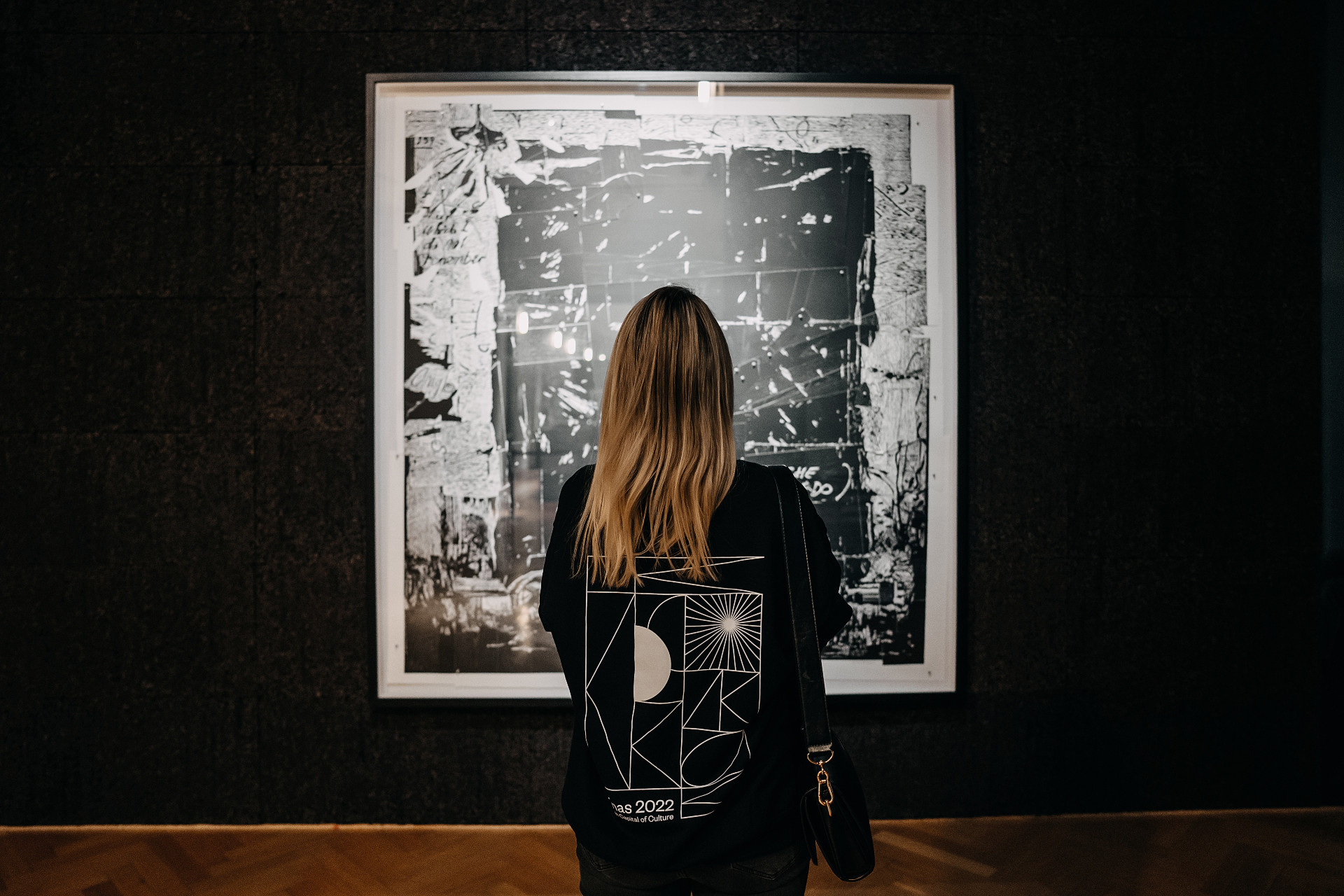
Increased media attention
According to Mr Reinikis, it was the subject of the European Capital of Culture that was most prominent in the foreign media. “During these six months, Kaunas was visited by 144 journalists from 19 countries. Articles, interviews and reports were produced, reaching a large foreign audience.”
“Kaunas 2022” was mentioned in articles in as many as 62 countries, including not only European countries, but also the USA, India, the United Arab Emirates, Canada, South Africa and Singapore. Readers of media portals such as the BBC, CNN, TIME, The Guardian, The Telegraph, Deutsche Welle and the Financial Times have learned about Kaunas.
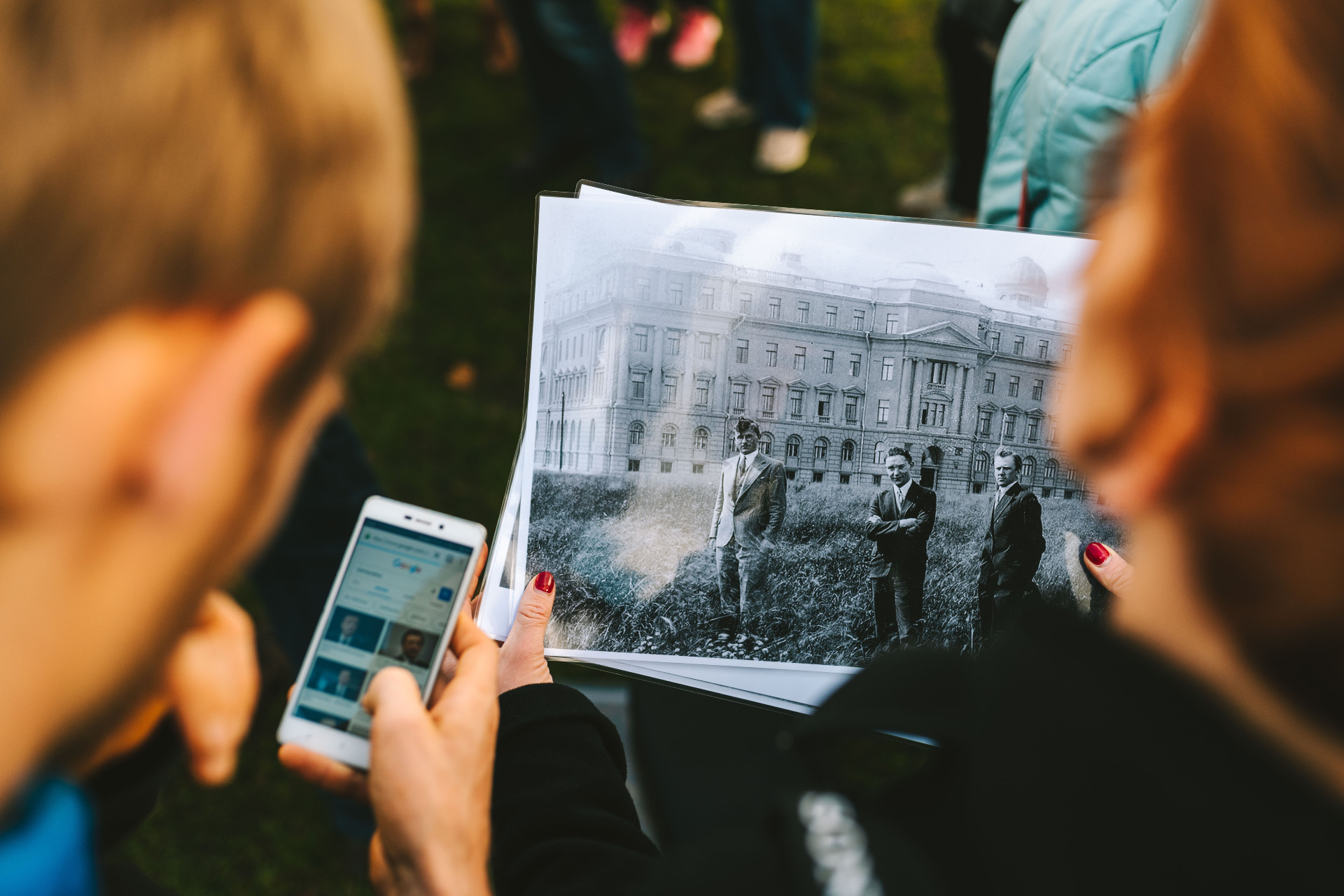
Even more culture as autumn approaches
According to the Director of “Kaunas 2022” Vitkienė, the impressive results of the first half of the year are not yet final. “These figures only reflect statistics for the months from January to June. In the summer, we invited visitors to several events: the contemporary city festival “Audra”, the performing arts festival “ConTempo”, and the Citytelling festival. Finally, the autumn will be full of events. Therefore, we are looking forward to sharing even better results at the beginning of 2023.”
The upcoming autumn will indeed bring even more cultural experiences to Kaunas. The following events that started in the summer will continue until the end of November: the Festival of Stories that will continue to revive the multi-ethnic memory of Kaunas and its surroundings, Jenny Kagan’s exhibition “Out of the Darkness”, which will present the history of the Kaunas Ghetto, the exhibition “The Learning Garden of Freedom”, which will be dedicated to the works of Yoko Ono, the premiere of the film “Folds”, a film that has travelled around the world, which is devoted to the modernism of Kaunas, and the Fluxus Festival, which is loved by the residents of the city.
The full programme of “Kaunas 2022” is available at www.kaunas2022.eu or on the mobile app.


